The Student Newspaper of The Nueva School San Mateo, California
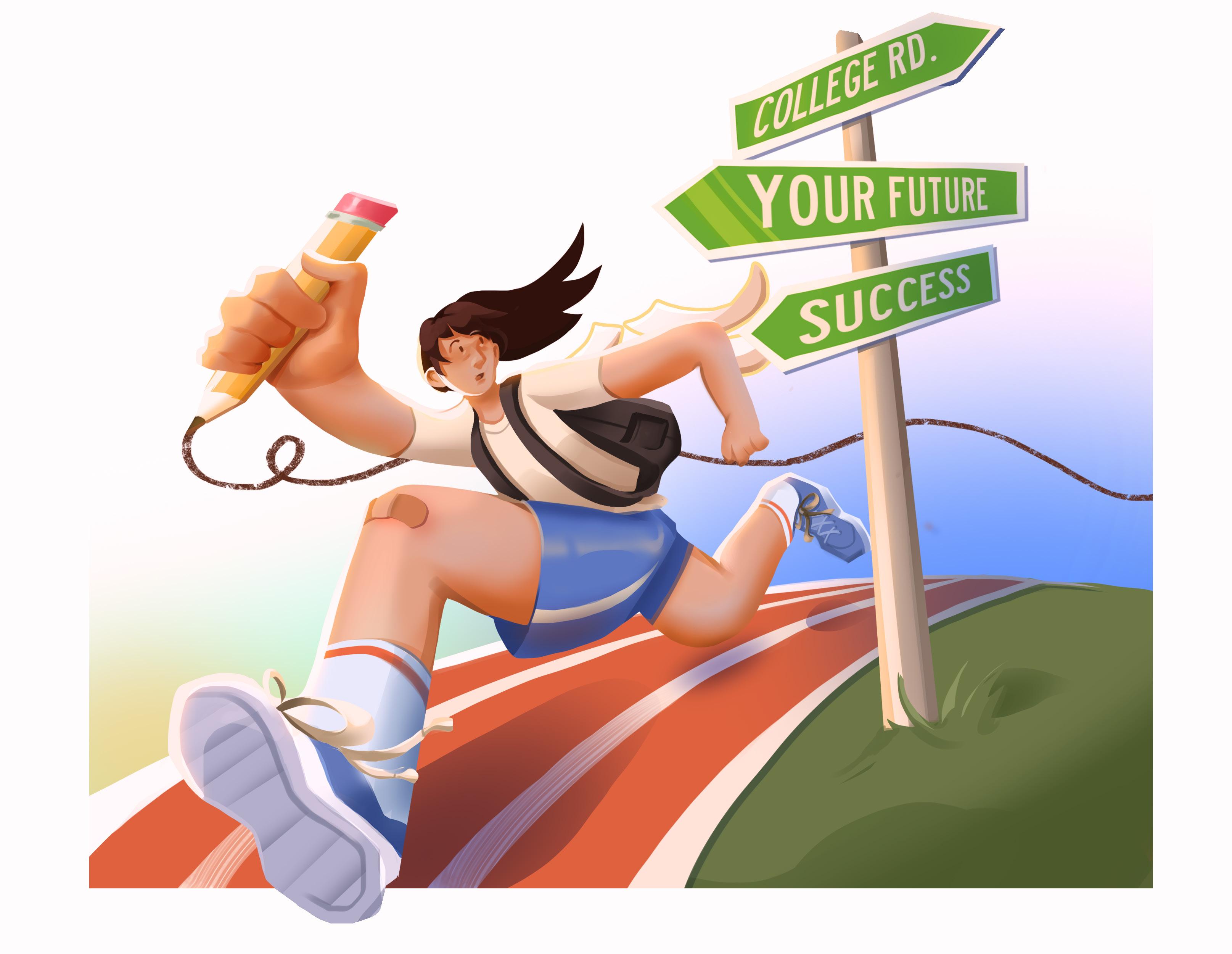


Part I: Great Expectations
Aday in the life of a Bay Area teenager in 2025: Since you were eight, it has been your dream to go to school on the East Coast and attend an Ivy League university. You are aware that many of your friends share these dreams. You have straight As, over 100 hours of community service, and are a two-sport athlete to balance out your academics. You know one classmate recently participated in a national debate competition, and you know another started their own non-profit organization from scratch. You worry if you

have done enough to stand out. And there is a reason you feel this way.
Specifically at Nueva, data from the College Counseling department shows that 35% of students from the classes of 2017–2020 and 36% from the classes of 2022–2025 attended highly selective schools with admissions rates as low as three percent and regularly top the Best National University Rankings from U.S. News & Report.
A side effect of these matriculation results has caused ripples among the student body. Some find that the consistency of high acceptance rate to highly selective universities of prior

years breeds lofty standards.
In a survey given to 113 Upper School students—roughly a fourth of the student body—the data shows that 88% of freshmen, sophomores, and juniors agreed that it was important for them to attend a highly selective college, and 69% agreed that attending one would be representative of their academic success and value.
One freshman wrote on the survey, “[If I didn’t], I would feel like going to Nueva was all a waste.”
The underlying pressure expressed in the survey does arise from some students sharing the same college goals—

and feeling like they are in competition for a limited number of spots—but external factors also influence it. For example, social media plays an outsized role in amplifying these feelings of competition by constantly showcasing peers’ achievements, college acceptances, and curated academic successes.
In mid-May, Nueva seniors gathered on the Rosenberg Lawn to participate in a social media trend that takes place every spring across the country: posting photos and videos of themselves in their college sweatshirts.
on Page 12

Story by Jordan F. Staff Writer
Additional Research by Colin C., Davis D., & Emma F.
After lunch, students line up to clear their plates in the compost bins, often scraping away untouched eggplant, Brussels sprouts, and meatfree meatballs.
A recent survey with a sample size of 68 Upper School students revealed that students, on average, throw out between 25 to 37 percent of what's left on their plates. Vegetables rank among the most common uneaten items.
“Food waste is a privilege. It is not something we should be doing,” said Mars R. ’27, admitting, “I don’t really want to be, but I would say I am a really big food waster, and sometimes if I really don’t like the food, I will just throw away the plate.”
Although the reasons behind food waste vary, the most common is taste and portion size, with 54 percent of students in the survey citing “not appetizing” and 33 percent citing “not hungry”.
“Most people only want to eat what they want, and you don’t want to be the rude person who says you don’t want anything. By not being picky, you're forced to be picky,” Anjali M. ’27 said.
Concerned about food waste, the Environmental Club led a half-day food waste audit in December. Club members found black beans, tortillas, chicken, and other wasted food in the compost bins.
“All three of the trash cans, not just the compost bin, were filled with a ton of wasted food that I think can be going to better places,” said Veer C. ’28, a member of the Environmental Club.
At the end of the audit, students found that 65 lbs of uneaten food were
thrown away. The school is working on anti-food waste efforts with a variety of individuals.
“We met with Rafa, the head of the Upper School Cafe, and what we learned is that in terms of other schools, Nueva does a pretty good job of reducing food waste,” Justin C.-B. ’26 said, a Co-Lead of the Environmental Club. “The cafe does a really good job when they don’t finish a meal to use it for sandwiches or use it for soups.”
Additionally, the Environmental Club welcomed Recology employee Brenner Mullin, who is attempting to work with schools in San Mateo to reduce food waste and trash contamination, to speak to students on campus.
At an Environmental Club meeting on May 7, Mullin offered resources and information about trash contamination and trash sorting efforts, including resources for the school to improve its food waste.
Despite these waste patterns, recent survey results graded on a scale from 1–5 for care indicated that students who reported caring more about food waste tended to throw away less food. Students who throw away less than the school average of 30.9 percent of their plates do care more about food waste than those who throw away more than the school average.
For some students, improving education and awareness is the next step in addressing food waste on campus.
“We need to change the culture around food waste,” Justin said.“I think we need to raise visibility on why food waste is harmful and why it is impactful.”
“I think it comes down to
By Jackson H. Web Editor

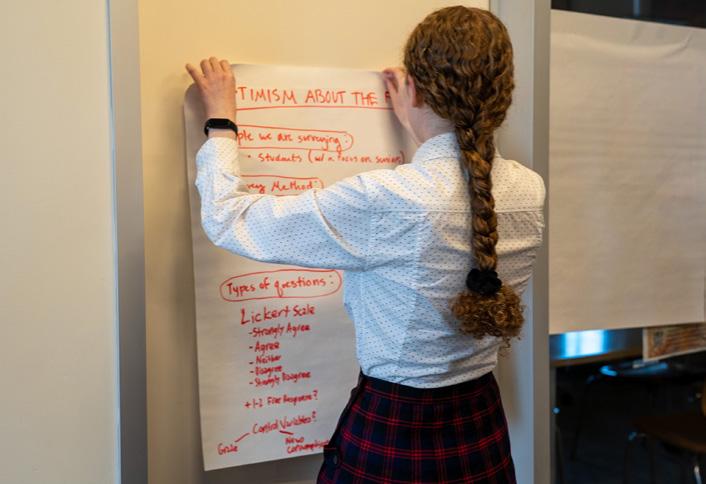

BY LANGLEY V.
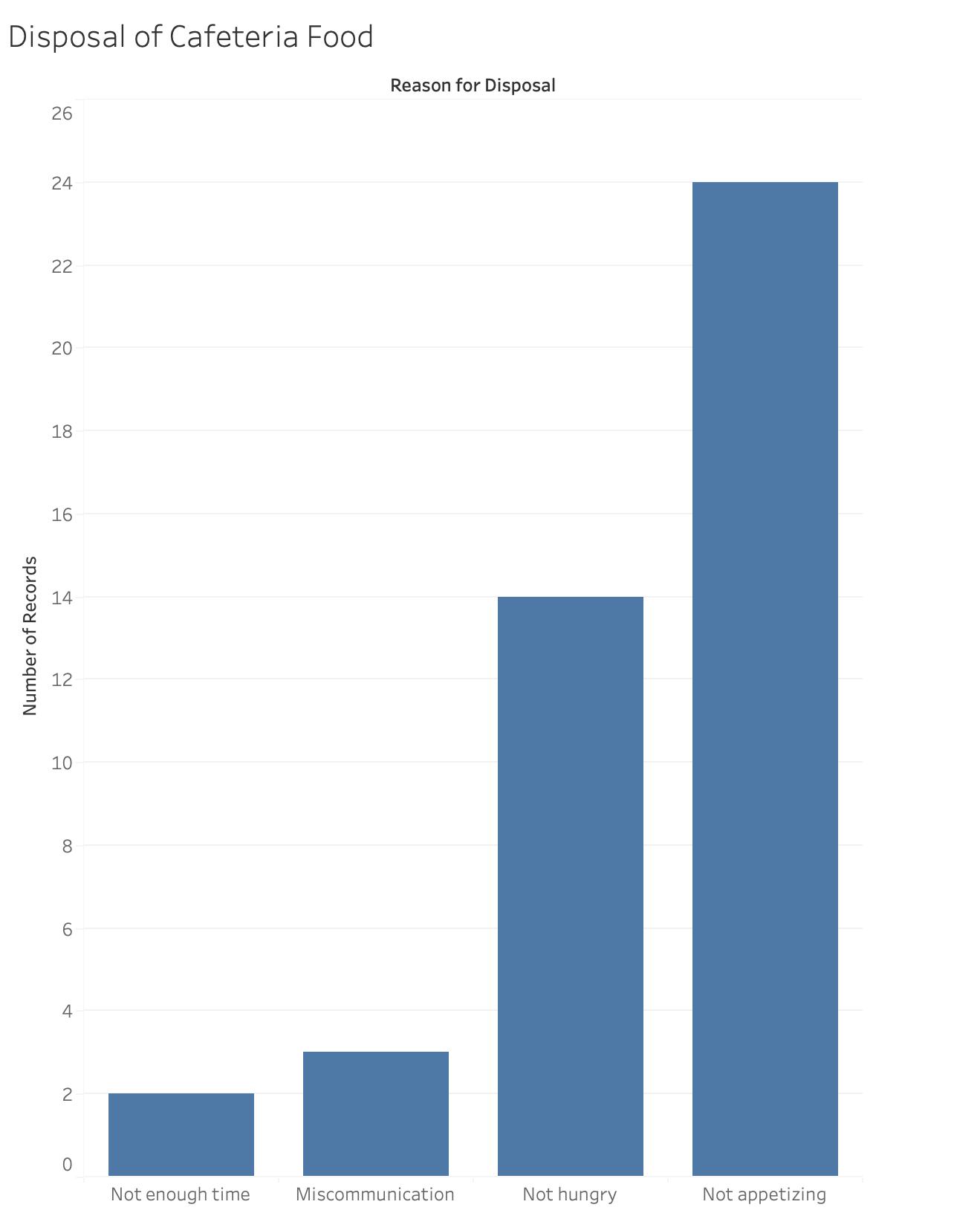
education,” Mars said. “We need to inform the student body about the environmental harms of food waste and the world hunger that exists. It is important to give that perspective.”
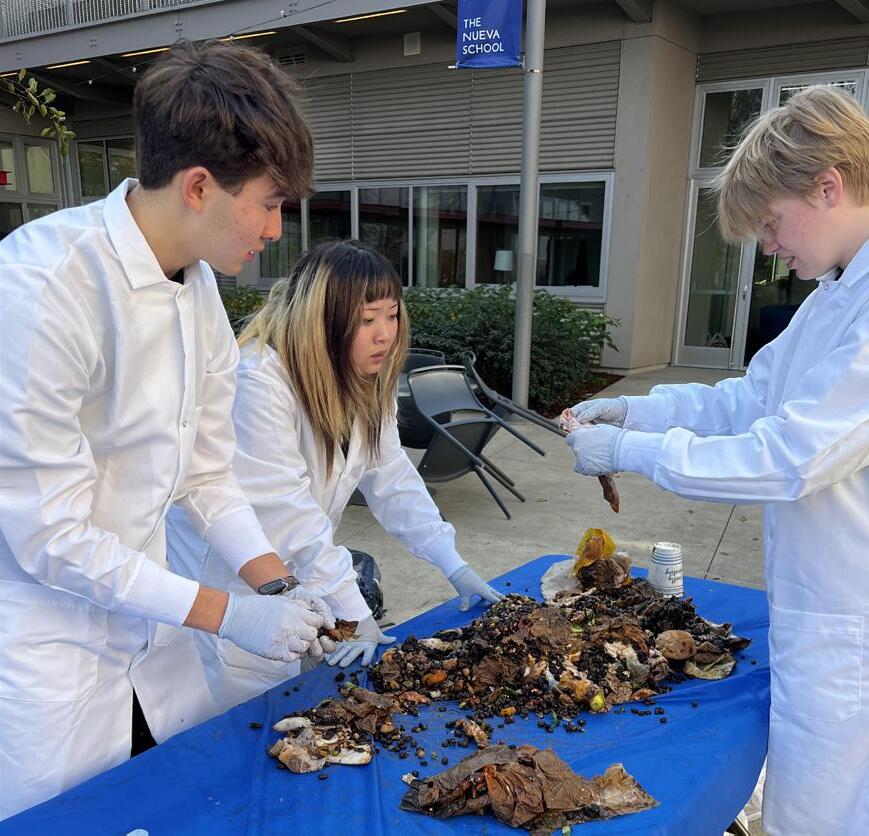
By
Student Council Representatives elected this year, a record number for the group, with several positions—even the number of grade representatives— doubled.



By Alvin Y. News Editor
On May 16, former President Joe Biden was diagnosed with an aggressive form of prostate cancer that ranked a nine out of ten on the Gleason Scale. The cancer had spread to the bone, signalling the severity of the disease. Although cancer, when spread to the bone, is incurable, survival rates from prostate cancer have almost tripled in the last decade according to prostate cancer expert Dr. Judd Moul, leaving a possibility for the former president’s recovery.

On May 8, Pope Leo XIV, born Robert Francis Prevost, was voted in as pope after the passing of Pope Francis in April following a swift two-day conclave. Prevost, a Chicago native with roots tracing to Sicily and Louisiana, is the first American to ascend to the papacy in the history of the Church, though he has spent the last ten years serving in Peru. Beginning his speech to a crowd of 200,000 Catholics with “Peace be with you all,” Leo emphasized the need for world peace, equality, unity, and humility among other values. Later, on May 18, in his formal inauguration speech in St. Peter’s Square to 250,000 attendants— including followers and world leaders from over 150 nations—his desire for love and unity was especially apparent, as he pushed for a Ukraine-Russia ceasefire.

On April 22, 26 Hindu tourists were killed by The Resistance Front (TRF), a militant group believed to have ties with Pakistani military-terrorist organization Lashkar-eTaiba. In response, India blamed Pakistan for harboring and supporting the TRF, expelled Pakistani diplomats, and suspended the Indus Water treaty, a water-distribution deal between the two nations that prevented Indian water blockades or manipulation and is key for Pakistan’s survival as a country. Later, on May 7, the Indian Armed Forces launched a series of 14 coordinated attacks targeting nine sites controlled by Pakistani terrorist organizations. The 78-year-old conflict between the two nations intensified, as Pakistan retaliated with a series of drone strikes before both countries began trading missile attacks. Eventually, on May 10, the two nations agreed to a ceasefire ending the flare-up immediately. Despite the agreement, both nations have accused one another of violating the ceasefire with continued military operations.
By Anvi M. Staff Writer
On March 22, almost 30 people walked into Saint Ignatius College Prep sporting shirts and hoodies branded with 4904 Bot Provoking, Nueva’s Robotics team name.
The robotics team made their way to eliminations, or playoffs, at the First Robotics San Francisco Regionals this year for the first time since 2018. During eliminations, teams play in alliances consisting of three teams each, with one alliance captain. With eight alliances total, captains of the alliances are generally the teams that placed high during qualifications, or scored the most points during their matches. While not an alliance captain, 4904 got picked for Alliance 7.
“It really is just an exciting moment to hear your team number called,” said Michelle Grau, MS and US Technology, Innovation Design and Engineering Coach, as well as the mentor for the robotics team. “Even when you’re pretty sure you’re not going to be picked, it’s hard to not hold out a tiny bit of hope anyway.”
Alliance 7, the team 4904 was playing for, got eliminated in Round 2 of the playoffs, but being chosen to play for an Alliance was

a huge milestone for the team.
While 4904 did not advance to the World Championships, they racked up enough points to get invited to an off-season event–the Northern California Invitational, hosted at Richmond High School. The Norcal Invitational is hosted every year for teams that scored high during Regionals but not high enough to qualify for World Championships, and this is the first time 4904 has been invited to a competition like this.
The drive was long for many on the team, but the result was worth it–the team ranked 16th in qualifications, and got chosen as a backup robot for Alliance 5. This meant that they
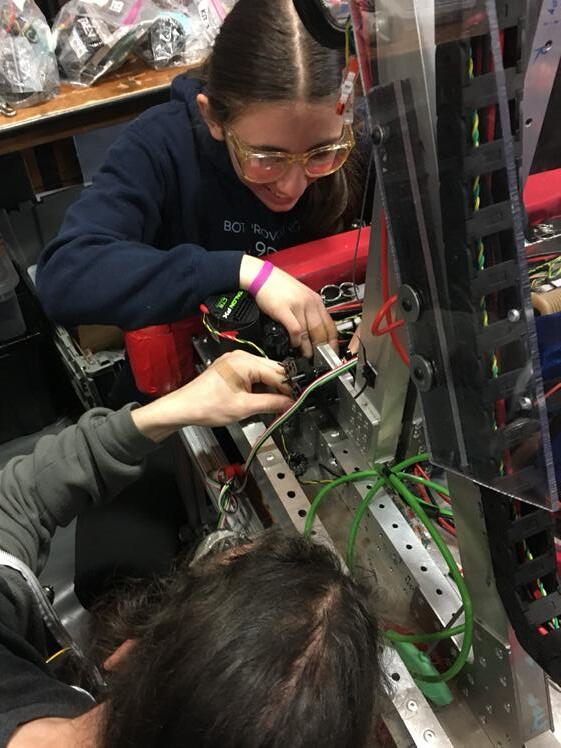
wouldn’t get to play in the qualifications–in theory.
But when the team captain, the 5104 BreakerBots, broke down after Round Two, 4904 had the chance to play one round in their stead. The team chose to showcase their defensive skills, keeping robots from the other alliance from scoring points.
Alliance 5 lost during Round Five by 61 points, but the experience was far from defeat for 4904. Being invited to the NorCal Invitational is a monumental achievement for the team, and shows that they’re already ready for next year’s competition.
Aggressive policing has packed city jails, though a drug epidemic and looming budget cuts will be a major test
By Callum S. Staff Writer
Lurie blitzed into the 2025 mayoral race, pouring a near-record $8.6 million of his personal funds into the campaign. Promising to utilize his philanthropic background and tough-on-crime outlook, he vowed to breathe new life into the struggling city.
Opponents questioned whether the Levi Strauss heir could translate his privilege into leadership. Six months in, his pavement-pounding approach has surprised skeptics, though budget woes and resistance from city services now test his momentum.
San Francisco remains in a “fentanyl emergency” with the city still reporting a staggering 50 overdoses monthly. To alleviate this, Lurie has shifted away from harm reduction policies, instead choosing to pair the distribution of smoking supplies with drug counseling. This policy looks decisive and feasible on paper, but it fails to address the crisis’s underlying causes.
Crime rates have dipped under Lurie, although this can’t be fully attributed to him, as most violent crime rates have decreased nationally since their peak during the COVID-19 pandemic. However, Lurie is beginning to crack down on open-air drug markets, sending frequent police raids and conducting mass arrests in the city’s Tenderloin and Mission
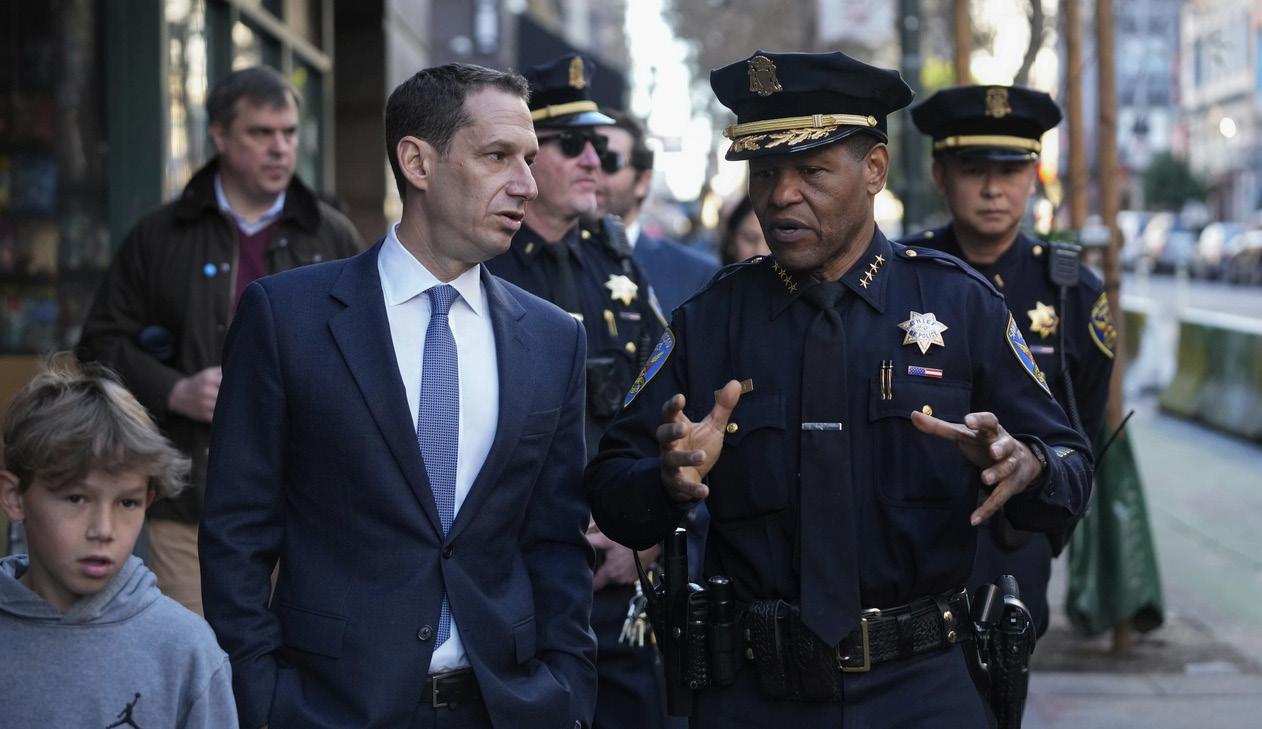
districts.
After years of leniency epitomized by politicians like Chesa Boudin, San Francisco is starting to take a harder line on crime under Lurie and District Attorney Brooke Jenkins. In May, the San Francisco Sheriff's Department released statistics reporting that the city’s jails are the most crowded they've been in 30 years, an impressive turnaround from a city that has consistently struggled to prosecute felons.
Despite his efforts, the iconic Saks Fifth Avenue in Union Square has shuttered its flagship store's windows after 45 years, a significant blow to Lurie’s hopes for a revitalized downtown.
To ease the 820 million dollar budget deficit—which Lurie says could balloon
to as much as two billion in the future— he plans to cut back on street cleaning and garbage collection, downsize city hall, and trim MUNI routes.
Yet, the mayor's office has limited authority in San Francisco’s fractious government structure, with commissions, boards, and the Board of Supervisors all wielding principal power over the path of the city. In April, Lurie’s mandate for a 15% budget cut in all city departments was unceremoniously rejected, with the sheriffs, fire, and election departments requesting even more money.
Lurie’s tough-on-crime pledge has translated into action, but San Francisco’s deep-rooted struggles demand more than just the Mayor’s efforts to sustain lasting change.
Data reveals that the large majority of students preferred the May trips from previous years
Story by Senya S. Staff Writer
Additional Research by Callan C. & Ainsley H.
Trips week has always been a highlight of the Nueva student experience. Students travel for a week to learn about subjects ranging from the legacy of indigenous Hawaii to the role of libraries in a democratic society in Boston and New York City. Trip members try new foods, meet new people, and develop new relationships with their classmates and teachers.
This year, the timing of Trips Week was moved up from late May to precede spring break in April. The changed timing has been the source of contention among the student body.
According to a recent survey of 104 Upper School students, 80.5% of respondents—excluding freshmen who did not experience the old schedule—preferred last year's timing to this year’s. While 82% of students surveyed rated their trips experience either a four or five out of five this year, 25% of respondents complained about extracurricular disruptions.
Notably, this year’s week conflicted with the Parliamentary Debate team’s national championships. Members of the team either had to fly separately to trips after the tournament had ended or not attend at all.
Additionally, the academic schedule following felt to some as if they were flung right back into a flurry of assign ments after returning from a two-week break.
“I came back after two weeks of do ing nothing and had MAs announced as soon as I came back,” one respondent said. “It’s tough to mentally switch.”
Next year, trips week will remain in April but has been shifted to follow spring break. Students will return from spring break for three days of school before departing.
According to Upper School Division Head Liza Raynal, various overlapping schedules were taken into account when deciding on trips week timing.

This year, after school-wide events— such as spring break, holidays, and admissions week—were factored in, athletics was the main priority for deciding the new time.
The California Interscholastic Federation moved finals for every spring sport to May. Prior to this year, May trips only impacted the highest level athletes at Nueva, but now it would impact nearly every student athlete participating in spring sports. In track, for example, CCS semi finals took place
in the second week of May.
According to Raynal, April will remain the best option for trips next year as well.
While March was originally a viable alternative, events such as parent-teacher conferences, the Innovative Learning Conference, and Decision Week— where newly admitted students visit the campus—made it difficult to schedule trips during the month.
If trips were moved to early May, sports timing would become an issue
Mike Swire, an environmental activist who lives in Bay Meadows, is known for being the “bike lanes person” at San Mateo city council meetings.
“Every night I go to a meeting or two, and they’re like ‘Oh, here’s Mike again,’ and they’re a bit sick of me,” Swire said.
The grumbles don’t deter Swire from his mission. He views the development of safe and protected bike lanes as one of the biggest equity issues facing San Mateo.
“There’s this misperception that the people who use bike lanes are middle-aged guys, and that’s not true,” Swire said. “If you go down to Humboldt, North Central, it is an equity priority neighborhood, and a lot of people there don’t have cars. So, bike lanes are the way they get to their job.”
Swire has been working in politics since he was in college, but has spent the past three years exclusively focusing on safe streets on the peninsula, which includes biking and walking as well as sustainable transportation. He said one of the biggest obstacles to safe streets in San Mateo is tax revenue being directed toward highway projects.
“Highways are the biggest sources of greenhouse gas emissions, air pollution, and crashes,” Swire asserted. “They say widening highways reduces congestion, but all it does is encourage more people to drive and, eventually, congestion returns.”
Swire, echoing the views of many environmental advocates, argues that even if expanding bike lanes means sacrificing some parking spots or extra traffic lanes,
the long-term benefits—less congestion and fewer cars on the road—make the sacrifice worthwhile. He said safety is still one of the biggest concerns San Mateo residents have to face when deciding to bike or drive.
According to a recent survey of 50 Upper School students, over 50% of students who bike have felt concerned about being hit by a car. Additionally, 65% said that if there were more separated bikeways (dedicated lanes separated with bollards/parking), they would bike more often, while only 19% said they would bike more if there were more bike routes without dedicated lanes.
One of those student bikers, Elin R. ’28, rides her bike daily to the Caltrain station to get to school; her commute to the station is 2.5 miles and takes around 15 to 20 minutes, depending on traffic. Recently, her biggest worry has been the removal of bike lanes on her usual route due to construction.
“I feel a lot less safe, and I think my commute is a lot more dangerous, especially because there are cars that don’t know how to deal with bikes sharing the street with them, even though that's how it's supposed to be using traffic laws,” Elin said.
Upper School Social Emotional Learning Teacher Sean Schochet also bikes to school and has been passionate about biking since he was in high school. He feels that the “shared roads” that San Mateo puts in place to encourage biking are performative and unsafe.
“Sometimes I'm getting honked at and I'm legally in my right of way using the lane because there's this bicycle
painted on the road, but cars don’t respect it and it’s dangerous,” Schochet said.
Schochet views biking safety as an issue that needs a shift in mindset from the community, along with safe infrastructure and support from the government.
“The community doesn't just transform into a biking community overnight by putting in lanes,” Schochet said. “It’s actually over time that bikers are seen on the roads, and that mindsets shift. People should be watching out for bikers and anticipating them more, because anticipation makes it safe as well.”
One example of how anti-bike lane mindsets can influence policy is the bike lanes on Humboldt Street. In 2022, protected bike lanes were installed along Humboldt and Poplar Avenues as part of a $1.5 million federal grant. However, the initiative also removed about 200 parking spaces from the area, angering some residents. On Monday, Feb. 3, council members decided to start the process of removing the bike lanes on Humboldt Street from Second Avenue to Indian Avenue to appease these residents.
“This is a perfect case of quick judgment and not letting a solution become the solution,” Schochet said. “They are overreacting to community outrage, in my opinion, without any data to see if it's working or not. Two years is way too short a time, because even if fewer riders are using it, over time, more riders would use it if they saw other riders using it, and then it would build up into a community that might utilize it more.”
and, if moved to late May, projected travel costs became too high. If trips were hosted in late April, AP testing would be disrupted.
“We certainly wouldn't want someone to choose an AP over a trip, that would break my heart,” Raynal said.
With this assortment of calendar conflicts taken into account, the early April timing became a necessary, even if unpopular, compromise.
Enhancing biking and pedestrian infrastructure around Nueva could increase safety for all. Check out some of the non-car ways that students and teachers get to school!
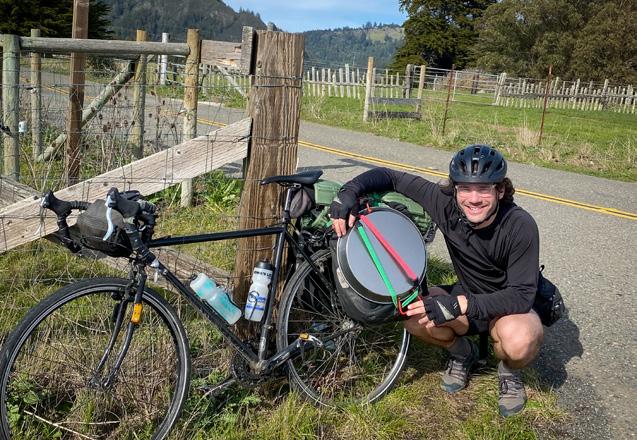


By Neel G. Staff Writer
By Ellie L. Culture Editor

AAs always, the annual Met Gala was held on the first Monday of May, where A-list celebrities showed off looks for the theme: Superfine: Tailoring Black Style. Unfortunately, many did not understand the theme of incorporating the history or examples of Black influence on tailored fashion, and instead wore tailored clothing that was black. However, those who did understand the theme excelled—like Lauryn Hill’s camp-y yellow suit designed by Jude Dontoh, Bad Bunny’s luxurious suit and pava hat that paid homage to Puerto Rican farm workers, or André 3000 who referenced underprivileged black musicians’ influence on fashion and music.
At the American Music Awards, Billie Eilish deservingly swept the competition, taking home all seven nominations. Bruno Mars, Lady Gaga, SZA, and Beyoncé all also took home multiple awards. While these wins were justified, Kendrick Lamar won only one award, despite leading the nominee list with ten categories for his legendary run of GNX. But what was most disappointing about this show was its several pre-recorded ceremonies and performances, and Jennifor Lopez’s tacky performance as host. After her failed world tour and public bashings, the AMAs truly could not have picked a more irrelevant host.

When legendary rock artist Bruce Springsteen criticized Trump in a Manchester concert, Trump called him a “dried out ‘prune’ of a rocker (his skin is all atrophied!),” and threatened him to “keep his mouth shut.” Trump has also posted about other artists who oppose him, like Taylor Swift and Beyonce. The actions of Trump are appalling and ex tremely immature. I commend like Springsteen who speak but Trump desperately needs to revise his unhinged tendencies and act like a professional leader.
year ago, director Zoe Swenson-Graham started thinking about Chicago. It was immediately after Mamma Mia, a cheerful musical bursting with joy and humor—the type of show they’d consistently done over the course of her time at Nueva. Chicago seemed fresh and darker, a jump into a genre of satire and drama that was entirely new.
Fast forward to the beginning of the semester: the cast voted between Legally Blonde and Chicago to select this year’s spring musical. Chicago won by just one vote.
Chicago is a dramatic, comedic show that tackles 1920s corruption and media sensationalization with giant dance numbers and glittering costumes. The 1975 musical follows Roxie Hart and Velma Kelly, two murderers who manage to walk free with the help of charismatic lawyer Billy Flynn. The two women compete with each other for attention, yet are similar to their core—selfish, dramatic, and obsessed with fame.
At times, the show is vulgar and racy, which left it up to Zoe to figure out how to handle Chicago’s maturity. Beginning with the teen version of Chicago, Zoe added back a few iconic songs and revised some dialogue—always including the cast in the decision-making procedure.
“I firmly believe that this is a collaborative process,” Swenson-Graham said. “Everyone’s voice matters.”
That collaboration was further reflected in the various tech teams that oversaw everything from bedazzled, sequin costumes to props like fire spinners and enormous fans.
As a part of the dramaturgy team, Willa N. ’28 enjoyed learning about the historical context of the show. She delved into crime cases that mimicked Velma Kelly and Roxie Hart’s, meticulously combed through each scene for pop culture reference from the 1920s, and compiled each fact alongside her peers into a presentation for the whole cast.
Willa began to understand the show, and its themes better in that process. For instance, she discovered that in 1920, Chicago Hungarian ethnic communities were reasonably isolated, suffered from city crime, and many of its members did not speak English.
In the show, the minor character Hunyak, a Hungarian immigrant who is an inmate along-

side Roxie and Velma, reflects this history.
Played by Lila P. ’26, she is the only innocent convict. She repeats two English words she knows—”not guilty”—over and over until her execution at the hands of the state.
“This is the one moment in the show where nothing is performative, and there is no joke,” Willa said.
On stage, Hunyak’s death is short, but shadows the rest of the show. Guilty convicts Roxie and Velma manage to get off completely scot-free, and remain just as narcissistic and selfish as before. Their comments on the state of America—“down in the news recently, but we represent the best of it”—and their peacocking ways gain a sinister edge, even amongst their champagne tassel dresses, the glorious finale duet, and the ensemble crowd of adoring fans.
“Who does the justice system serve? How do we, as a society, treat the people there? How have we improved [since the 1920s], and what work do we need to do?” Swenson-Graham said. “The questions [posed by the show] are timely.”
The seriousness of the show’s themes was alleviated by a lighthearted and tight-knit cast. Archie B. ’26 describes the Nueva theater community as one of the most welcoming

FWhen the furry monster dolls first rose to fame, I didn’t have a problem with them—people can buy what they want to! However, as they took the media by storm, I couldn’t get away from their spheres of influence. Originally made by Hong-Kong based artist Kasing Lung, celebrities, influences, and ordinary Labubu-fans alike now accessorize their most expensive belongings—Birkin Bags, Porsches, jeans—with the overly expensive dolls that can cost up to $180. While cute, they aren’t cute enough to devalue the aesthetic of other expensive items and overtake pop culture to the point of no escape.

By Alexis C. Web Editor
With an endearing turquoise app icon and intuitive interface, the fast-growing social media and food rating platform Beli allows users to connect with friends and bond over recent meals.
Similar to most social media apps, friends can interact with posts on their feeds, and view each other’s “Taste Profiles”—which showcase statistics such as total restaurants eaten, favorite cuisines, and highest ranked cities.
Beli’s ranking algorithm assigns numerical ratings to each restaurant by asking users if they preferred their meal to a previously visited, similar one. As rankings rack up, user “Been” lists (which are sortable by cuisine, location, price, and more) grow. In addition to “Been” lists, Beli has features such as a map display of previously visited restaurants, a feed for friend rankings, and ways to bookmark bucket-list places.
Lara M. ’25 first heard of Beli on social media, where its Instagram account @beli_ eats posts reviews of popular restaurants in major cities. It wasn’t until a friend suggested Beli that Lara downloaded it.
One of Lara’s favorite aspects of the
social community on Beli are the reviews, which not only describe the food but also the overall experience of eating together, in person.
What differentiates a Beli post from other food rating apps such as Yelp, is the ability to tag friends in reviews. Additionally, only followed users appear on one’s feed— meaning that showcased reviews and posts are full of familiar faces.
spaces he’s ever been in.
“Whether you’re a freshman or a senior, everyone has a place in the class,” Archie said. It’s a lesson that Jasper F. ’25 internalized as a freshman in his first high school show, and one he tried to model as a senior.
“I always try to branch out to talk to and meet the new people, make sure they know they’re welcome and they belong,” Jasper said.
That friendly spirit colored the entire production: cast dinners after late night rehearsals, little dances off stage to the beats of Funny Honey, and inside jokes around Jasper’s line: “Step down, daddy.” The line even made its way into the first ever senior night, a new event during the cast party organized by the underclassmen, on Fernald’s senior poster.
The night itself was incredibly special for Mari M. ’25, who saw the tradition as a culmination of all the new connections formed over the course of the semester.
“The night just made the seniors all feel so loved,” Mari said. “And so something I’ll always remember about this cast is how the underclassmen and juniors are carrying forward that culture of love and joy—picking up the baton as it were.”
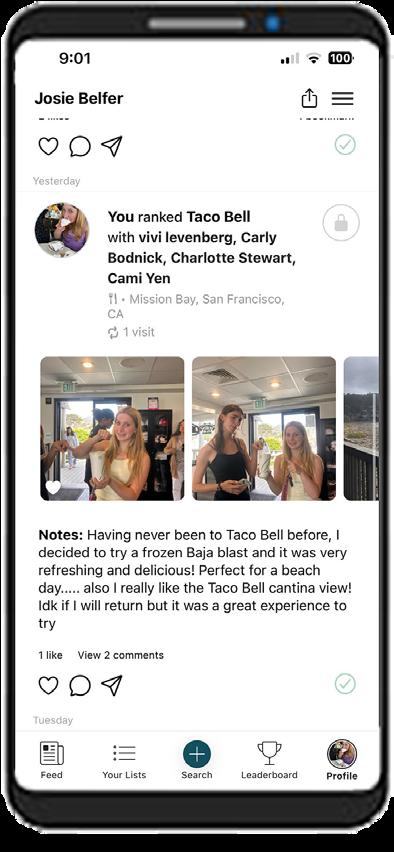
“A lot of times when people do reviews on Beli, they explain their whole experience going to that restaurant, their afternoon and then evening—what they ate and what activities followed. That’s really fun,” said Lara.
Lena C. ’25 really appreciates the “casual” and “cute” community on Beli.
“Everyone loves food and everyone loves each other,” said Lena. “It also makes going out to eat with friends exciting—we’re like, ‘let's put this on our Beli!’”
The Beli community also provides recommendations and advice for future restaurant patrons. “When I put all my details in about what I liked about how I think I made some ordering mistakes, then my friends were able to use my review to say, ‘Oh, okay. This is what we should get,’” said Lara.
For Annabel Y. ’27, there is joy in seeing the

restaurants that friends visit around the world.

“It's super fun to see other people [use Beli], especially when they're visiting other places—I know people who went to Mexico or New York,” Annabel said.
In addition to the social side of the app, Beli gamifies restaurant-going with a leaderboard of the most active users. “Because I got the app, I want to visit more restaurants so I can keep adding to my list,” said Annabel.
Despite the social media platforms that have fizzled out, like BeReal and Locket, Lara believes Beli is here to stay.
“I'll remain an avid loyal user because it's a really fun way to detail my life and to reflect on things,” said Lara. “As I go into college and expect to travel more, I'll definitely use [Beli] to detail my life and experiences, and I'm excited to keep doing so.”
Despite changes, Sushi Edomata hasn’t lost its excellence
By Neel G. Staff Writer
Just a nine minute walk away from the Upper School campus, Sushi Edomata is a favorite among San Mateo residents—and deservingly so. Formerly known as Sushi Sam’s Edomata, the restaurant rebranded and reopened in a new location on April 9, after the retirement of their owner on Dec. 28, chef Sam Sugiyama. Because of their fresh, authentic food, they are in high demand; a reservation is needed to be seated.

Their Nigiri is divine—the expertly cut raw fish paired with rice is so simple, yet so delicious. You can taste the freshness of their fish, as it is directly imported from Japan. Specifically, their Umimasu, a smoky trout topped with onions, is impeccable and a must-have for customers.
If you are seeking a more complex combination, their Sam Special Temaki (handroll) is packed with a rich umami sauce, crispy shrimp tempura, soft rice, wrapped in seaweed. Their Negitoro Maki Sushi (cut hand roll), which has fatty tuna and green onion, is also exceptional.
The corn tempura side perfectly with the sushi. The moment you bite into the crispy crust, the tender corn, seasoned to perfection,will burst in your mouth. All their tempura is delicious, but the corn tempura stands out for its well-rounded flavor profile, the perfect
mix of salty and sweet.
For those inclined more towards a purely savory palate, however, check out the udon or White King Salmon Nigiri. The udon is lovely in its home-y flavor, accompanied by a simple chicken broth. Their nigiri is fresh, just like the rest of their excellent sushi.
Overall, Sushi Edomata excels in authentic sushi and classic dishes. As a patron remarked, “not one thing has changed in the food since the relocation.” Sitting barside and watching the skilled sushi chefs was an especially engaging experience; not only does Sushi Edomata have amazing food, but they also have a welcoming ambience that deserves all its laurels.

By Senna H. Staff Writer
Historically, I’ve been a huge fan of anything lavender-flavored, but with my iced Lillian Latte, an expresso drink? with lavender and french vanilla, I couldn’t taste the lavender or the vanilla at all in the sweet way I expected.

it may have simply been a lower-quality roast.
Their menu features variants of waffles, omelettes, and toast—and a crossover I was particularly excited to try–a “womelette,” an omelette cooked in a waffle iron. With a rubbery texture and the flavor profile of blandly seasoned egg, my bacon womelette was underwhelming at best. It was a nice
The fan favorite taco truck lived up to my expectations, and more
By Neel G. Staff Writer
The moment I took a bite from a few tacos some seniors brought back during lunch, I instantly under stood the hype around the local taco truck, Jayli’s Cocina. Located on 28th Avenue at the El Camino intersection, a five minute walk from Nueva, the
The beauty in their dishes lie in the meat; tender, juicy, and abundantly sea soned to perfection.
truck has become a fan-favorite among students—for good reason.
The classic tacos are my favorite item, overfilled with delicious meat, vegetables, salsas, and tipped off with lime.
The beauty in their dishes lie in the meat; tender, juicy, and abundantly seasoned to perfection, it pairs perfectly with fresh cut onions and peppers and warm tortillas. Whether it’s carne asada or al pastor, there’s no way
The high- light of
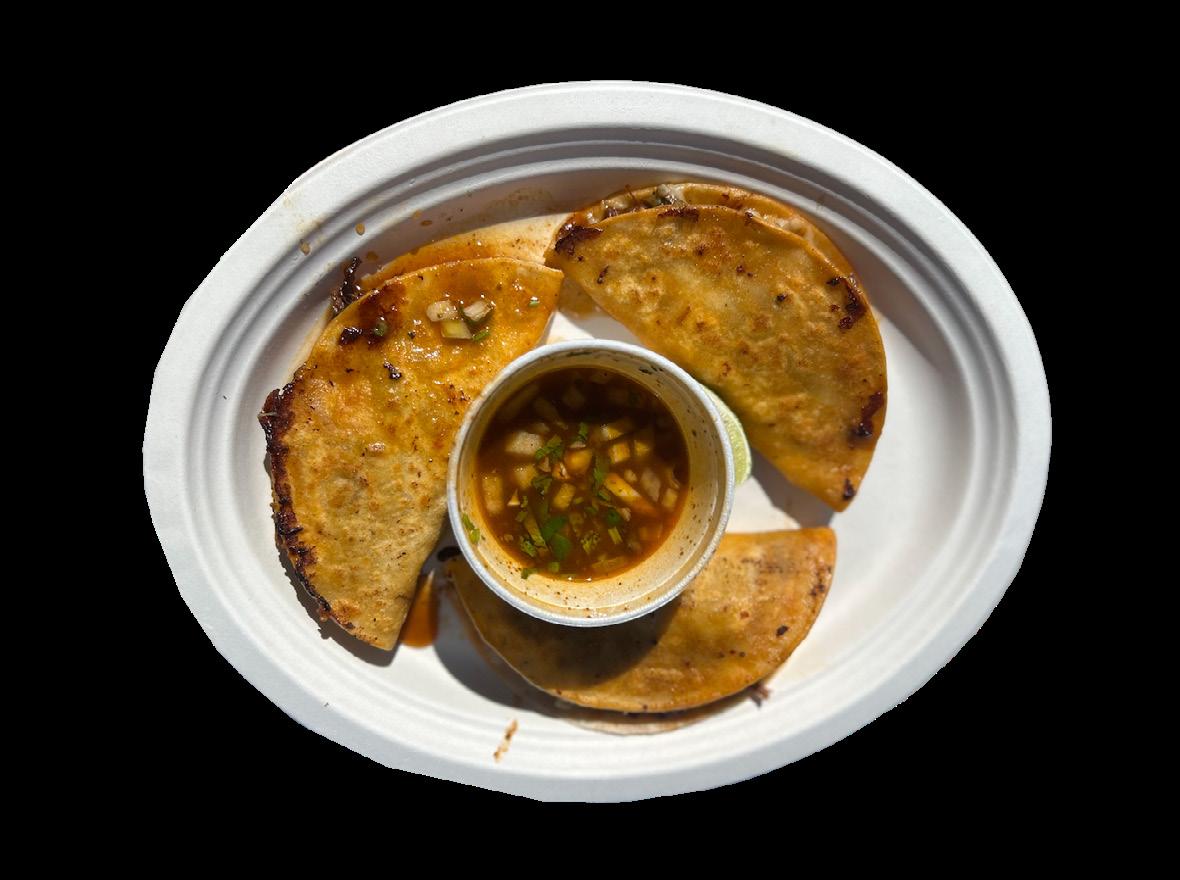
On the more extravagant side, their mouth-watering birria tacos are up for the job: they’re packed with spices and juicy meat, and the birra soup balances perfectly between tangy, spicy, and savory. Their sopes are also cooked to perfection, with a satisfyingly crunchy base.
Bmy visits to Jayli’s Cocina was their churros. With a crispy crust and soft dough, the warm cinnamon-y dessert ended my meals flawlessly. For another cinnamon sweet treat that’s on the colder side, I’ve enjoyed their refreshing horchata, which isn’t overly sweet and pairs flawlessly with the hot weather.
Jayli’s Cocina truly lives up to the praise I’ve heard. Next time you’re hungry after school, instead of walking to your run-of-the-mill Chipotle by Whole Foods, try Jayli’s Cocina instead.
right but bare, Penelope’s has a sleek interior with pops of teal, emanating a both classy and modern ambience.
The café’s roots come from the Greek island Crete—yet the menu is dominated by items appealing to an American palate, with only a few options harboring Greek origins. While the café offered a multitude of drink and food options, the items I tried lacked the nuance I was looking for.
For a similarly priced breakfast, they offer a variety of waffles–from bacon-topped to cookies and cream. I tried the strawberry nutella waffle, which was decent, but not mind-blowing. Though the waffle

vorable qualities [in my book], it wasn’t mindblowing by any means. Plated with a drizzle of Nutella and some cut-up strawberries, it tasted fine, but nothing I couldn’t make at home.

Iordered a Party at the Beach, which was described as having notes of strawberry, peach, and coconut with a green tea base. The peach flavor emerged as the most prominent, while the strawberry and coconut went unnoticed. The drink’s sweetness bordered on medicine-like, but as someone who likes that cloying taste, I found it refresh ing.


By Senna H. Staff Writer
From the start, Hurry Up Tomorrow was a movie lacking direction and plot. When I walked into the Cinépolis theater, I was greeted with an eerie emptiness—my friend and I were the only ones there. The sense of desolation mirrored that of the movie, which had storytelling just as empty as its seats.
Directed by Trey Edward Shults, Hurry Up Tomorrow follows a fictionalized version of “Blinding Lights” singer The Weeknd, as he struggles to live up to his persona. The story centers around three characters: The Weeknd played by himself, his manager/friend Lee (Barry Keoghan), and a mysterious fan named Anima (Jenna Ortega).
At the start of the movie, the audience is thrown into The Weeknd’s preshow routine, watching him perform onstage in a disorienting combination of concert film and documentary-style storytelling. Onstage, his voice cracks, as inspired by a real event, and he rushes off, attempting to exit the venue. Before he does, Anima intercepts him, and the
following sequence of events devolves into what felt like a delirium. What seems like a fun night between the two of them quickly and confusingly deteriorates into a hostage situation and the gruesome murder of The Weeknd's manager, Lee.
This storyline fails to produce anything cohesive, instead resembling an assortment of disjointed ideas haphazardly glued together with gorgeous cinematography but little substance. The film suffers from a lack of grounding in place, time, and plot, amounting to something that even established actors Jenna Ortega and Barry Keoghan couldn’t save.
Anima’s motivations and backstory are never explained to the audience—even her name is never explicitly mentioned in the film. The audience views only a few choppy scenes portraying her as unhinged, and receives maybe two vague lines about her mom. Similarly, Keoghan, playing Lee, is solid, but his character ultimately rings hollow, with his history never being explored.
Tesfaye’s acting leaves much to be desired, extending only to his ability to shed a few tears—he cries for maybe a fourth of the movie—and not much else. His performance wasn’t believable, but it wasn’t anything unexpected, given his lack of acting experience. The fictionalized version of himself did his acting no favors as well; for the first thirty minutes, The Weeknd barely speaks, leaving the dialogue—and thus, any emotional connection with the character—sparse and flimsy. It also left the movie awkwardly attempting to balance fleshing out a skeleton of a storyline and cutting the unnecessary scenes to carve the way for what could have been a decent narrative. The rest of the movie was such a mess that it overshadowed Tesfaye’s poor acting, as even without it, my impression of the movie would have been just as negative. The film assumes that the audience is already intimately familiar with Tesfaye’s persona, making it difficult for those unfamiliar with him to engage with the character and leaving his character shallow and half-baked.
As someone who is not a dedicated listener, I was not invested in his issues. However, I do applaud him for being vulnerable and showing us what it’s like to have a persona—something I, of course, cannot understand. In that way, this film is a vessel of explanation for his fans—a glimpse into why he’s saying goodbye to The Weeknd and embracing his “real” identity, albeit through an exaggerated and convoluted plot.
The cinematography latched onto that incohesiveness, though the camera work and directing were two of the few things I enjoyed about the film. The camera moves with the characters, with few still shots, contributing to that immersive yet disorienting atmosphere. If anything, the visuals served as the driving force of the storyline—at least more than the dialogue or characters did.
A fan of The Weeknd may find something to appreciate in this chaotic, fever-dream of a film, as it offers a glimpse into the artist’s farewell to his persona. But for anyone who isn’t already a fan— don’t waste your time.
By Lexie S. Staff Writer
We've rounded up the best of culture to watch, listen, eat, and do right now
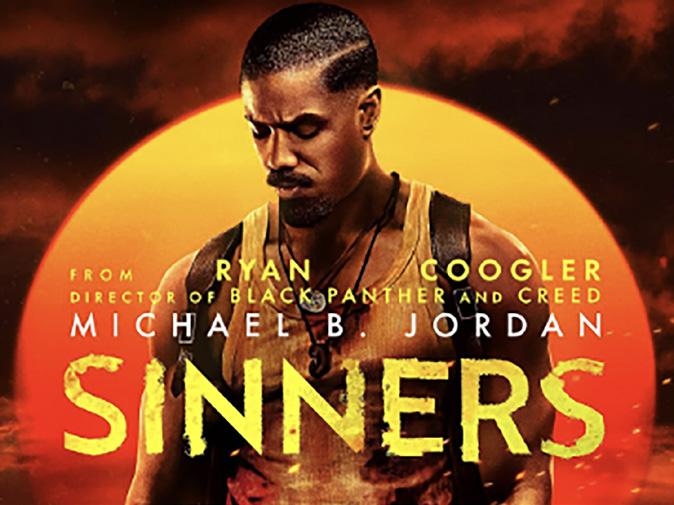



Vampire movies typically take place in a Victorian setting, but Sinners provides a fresh look on the genre, taking place in 1930s Mississippi Delta. The movie starts off explaining how music is connected to vampires, which ties back in halfway through the movie when music becomes so powerful that it draws the spirits of musicians from the past and future to the same room. Set during a time of segregation, the movie also revolves around the experience of life during the Jim Crow era, incorporating racism into the introduction of the vampires in an unexpected way. Sinners is an innovative fusion and an entertaining, layered movie that is perfect for your next watch.
A hot summer afternoon, a crowd of people, and a county fair. That’s enough to keep you busy all day, with an endless amount of rides and games, a farm that has a petting zoo and animal races, and typical carnival food like hot dogs and fries to keep you stuffed to the brim. The array of rides ranges from tame, bumper car-like rides, like the ring of fire, a roller coaster that spins you upside down in a circle, and the zipper, which twists you both in a cage and in the tower. This year, the San Mateo County Fair will run at the event center in San Mateo until June 8, leaving you four last days to enjoy the attractions, games and festivities before the fair closes its gates for the year.
WITHERED is d4vd’s newest pop album, a compilation of 15 songs and 15 different emotions. Each song presents its own emotional journey, some with a more melancholy feeling, others with an upbeat energy, like “Feel It.” Halfway through the album, there’s an interlude called “Invisible String Theory,” a minute and a half candid yet emotional conversation that sets the scene for the rest of the album. The album offers a multitude of memorable tracks, each perfectly performed by d4vd’s raw, natural voice.
As summer begins, so does the third season of The Summer I Turned Pretty. With about a month left till its debut, you’ve got the perfect amount of time to read or reread The Summer I Turned Pretty trilogy. Even if you’ve already read the series, it’s the perfect refresher for the upcoming final season. If not, it’s a perfect introduction to the series and a good companion for summer, as author Jenny Han portrays the season in such a magical way, it feels like you’re in the beach house with them.

By Ellie L. Culture Editor & Senna H. Staff Writer
Recent cuts to research funding have shaken the American scientific community. Nueva students and faculty unpack its impact.
n the beginning of 2025, Nancy G.-M. was on the lookout for summer science research opportunities.
She applied to various programs and sent some cold emails to labs and professors. Soon, she received several disappointing replies explaining that recent cuts to research funding were forcing labs to cut back. Some labs could not even afford to take on undergraduate researchers—certainly not high schoolers.
Although she still managed to land summer lab work at Stanford University, the situation has remained with Nancy, especially as cuts to scientific research continue.
“It’s already super tricky for high schoolers to get access to research or lab experience,,” Nancy said. “[But the] overall downscaling of research is a larger issue. What will research in the US look like in the next five, ten years if this [continues]?”
It’s a question that has circulated through the American scientific community over the past few months as the Trump administration has sought to freeze or cancel federal funding allocated towards scientific research at universities. The effects have gone beyond labs; institutions like Columbia University and the University of Pennsylvania have laid off hundreds of staff, paused hiring, and preemptively decreased the number of graduate students they will accept in the next year.
In addition, recent research cuts have disproportionately targeted LGBTQ+ health and other topics tied to supposedly “DEI” efforts—such as gender dysphoria, HIV, and vaccines. Staff at agencies like the NIH and NSF have reportedly been directed to deprioritize such research, under the justification of “agency priorities.”
For biology teacher Lindy Jensen, the long history of American public research funding informs her perspective on the funding cuts. Having worked in research since 2013, she recognizes the importance and history of biomedical research funding.
“In the 20th century, the explosion of biomedical funding in the US helped millions of people with modern synthesis [techniques], sequencing of the human genome, etc. We’re the biggest spender in the world, and a crazy outlier, really,” Jensen said.
However, in the 2010s, Jensen began to notice a decrease in NIH funding. While budget numbers stayed about the same on paper, they didn’t account for inflation.
“The writing’s been on the wall, so to speak, for biomedical researchers,” Jensen said.
As such, Jensen was unsurprised when funding cuts began to hit the news in January. Still, she emphasized the clear distinction between the slow weaning of funding of the 2010s and the recent budget cuts that the NIH and NSF have suffered, alongside massive staff layoffs.
“There’s a difference between cutting funding and cutting the function [of these
institutions],” Jensen said.
Other government science agencies and labs like the NOAA, EPA, and the USDA have suffered similar layoffs and budget cuts, particularly in programs focused on climate change and environmental research.
At first, the government agency changes seemed distant to Justin C.-B., co-leader of the Environmental Club. Then a few weeks ago, in the process of researching the 1960s environmentalism movement, an official government internet archive disappeared right before his eyes. The moment crystallized how politics currently influence research and can hinder environmental progress. In the context of the Trump’s administration’s stance on climate change, environmental politics has gained a new relevance for him.
“The climate crisis is fundamentally a democracy crisis,” C.-B. said. “Right now with the Trump administration, we’re seeing a constitutional crisis. It’s all connected, isn’t it?”
“There’s a difference between cutting funding and cutting the function [of these institutions]."
Chemistry teacher Jeremy Jacquot similarly emphasized the link between politics and science. He defined federal funding as a major touchpoint.
“[With funding], we're demonstrating that we, not as individuals but as a country, value [this research] right now and want to push for these breakthroughs. That is kind of a political decision,” Jacquot said. “And of course, different administrations, with different priorities, sets of beliefs, and constituencies, will value [each] area of research in different ways.”
Jacquot has still been taken aback by the extensive cuts to so many different areas of research. While he expected sustainability research would be targeted, he didn’t expect that biomedical research funding would be subject to the same scrutiny.
That assumption aligns with the historical trends of biomedical research funding. However, these recent funding changes have disrupted the field so substantially that research opportunities will be affected not only now, but also years into the future, as emphasized by a Stanford biomedical researcher who has begun to experience these cuts. The researcher was granted anonymity on the grounds that their lab could potentially be targeted and lose even more research grants if identified.
“[Most] research is not done on a four-year cycle, [or] based on when people are voted into office,” the researcher said. “But these decisions that happen in the course of six months to a year can have consequences on the volume of research, the quality, and the training [of] a future workforce in biomedical research, that will potentially persist for decades.”
Jehnna Ronan, the head of the science department, has similar concerns over how the developing scientific workforce will be impacted. Not only has cut funding affected current researchers, but it also shrunk the pool of potential future scientists and researchers with less graduate spots being offered at universities. With the recent exodus of senior scientists, there is less time and bandwidth to onboard and train new researchers.
“There's going to be a generation of people who thought they wanted to be scientists, wanted to get into it, weren't able to, and just had to take a completely different path, which is disappointing,” Ronan said. Even for researchers who have their funding officially returned, they may continue to run into obstacles. Andy M. is especially concerned by these various bureaucratic aspects of science, having talked to biologists focusing on ecosystems during a school trip to Montana about their loss of research funding.
“The internal government organization responsible [for those logistics] has been gutted,” Andy said.
Jensen has already seen these issues play out with the trajectory of a friend, a postdoctoral scholar who submitted her request for continued funding as usual in November. But by the time January rolled around, the usual NIH panels were paused, and all requests were stalled. Though panels began to slightly pick up in April, Jensen’s friend will still have to discontinue her research soon.
“She’s prepared to be unemployed come June,” Jensen said.
Already, these fears have trickled down from higher education to high school. For Sydney E., the cuts also bear an extra personal baggage beyond her own ambitions.
At the beginning of the school year, Sydney lost a close family member to cancer. It was the end of a long battle with the disease. In that time, the family member participated in a research trial for a cancer medication that mitigated the disease’s health toll and likely extended their life.
But in the last couple months, cancer research funding has significantly decreased.
“It's so hard to imagine that other people are not gonna be able to get the [chance for the] same treatment and resources. At least in my mind, that's unacceptable,” Sydney said. “If we have a potential to help people and to save lives, cutting funding for that is just a slap in the face to anybody whose lives have been saved by research.”
Ronan echoed similar sentiments, noting the complex role that science has played in American history.
“Science is not always a force for good, but I do think we need science moving into the future to solve a lot of our problems,” Ronan said.
NIOSH panels, which approve health and scientific requirements for respirators, have been cancelled. This means that the medical companies that make masks can change the formula of their products without safety approval. These masks are used by scientists, construction workers, artists, and more.

With many scientists losing their grants, private research, sponsored by companies like Google, Amazon and Meta, may take that place. However, though the companies have pledged to make their research publically available, they don't have the same incentives as other scientific researchers, especially if their research relates more to their products, and gaining more customers.


Although car prices don't seem related at first glance, the general de-funding of university research is a hamper upon research related to innovation, especially electric vehicles. What this means is that it'll be harder for car companies to develop new, better, more advanced cars—and paired with tariffs, this does not bode well for the general prices for cars, in the short and long term.
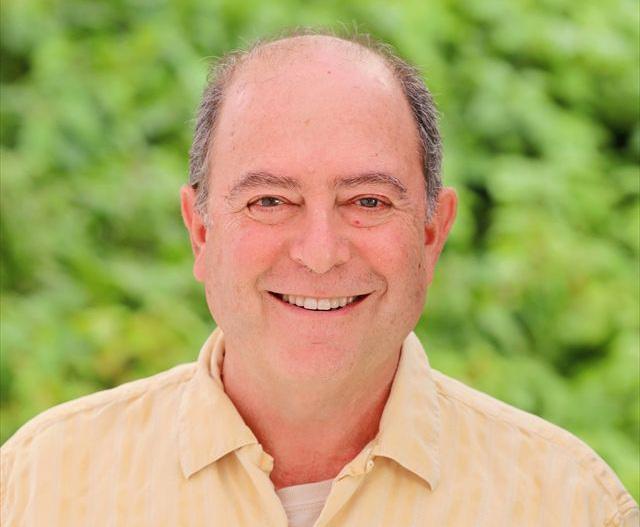
By Emily F. Staff Writer
As a founding member of the Upper School faculty, Mark Hurwitz has spent the last 12 years teaching physics at Nueva. The end of the school year is approaching and with it, the end of his time at the school. In a conversation with The Nueva Current, he reflected on his time at the Upper School, and shared some thoughts on what’s next.
How do you feel as the end of the year approaches?
I've been trying to seek out some of the other people that have been around for a long time and spend a little extra time with them. For example, next week, I'm going to go out with Jen Paull and Jen White, our founding English teacher.
What's your most meaningful memory?
I have memories scattered over the years of students doing notable things. I love looking over the graduation lists of past years, scanning the names, and remembering. We've sent a bunch of really fun students out into the world, and hopefully we've helped make the world a little bit of a better place by doing so. As a rule, Nueva students are very capable. Most would do just fine anywhere. We hear different versions of this story from parents and others. But it's also clear that some students really need a place like Nueva. Those are the ones that I think maybe are even more special and fun to have taught.
What was your favorite Nueva event?
In part because it had such unique challenges, the Peru trip in the opening year is one that I will never forget. The first night, one of the students discovered that they had forgotten a life-saving medication. The Head of the Upper School and others got in a taxi and drove around Lima at midnight, seeking out a 24-hour pharmacy. Later in the week, a student fell into an outhouse hole, sort of. One morning we had an early-morning bus ride, and the road was narrow with a drop of around 100 feet on one side. Our bus had to back down to make room for a truck, and the bus was just inching closer and closer to the edge. I was worried that the road would crumble under the weight of the wheels. Then a bunch of the kids saw how dangerous it was and surged toward the downhill windows to get the view, putting even more weight on that side. The Head of the Upper School and I were freaking out. Anyway, it felt like the entire trip was a series of near misses and misadventures. It was incredibly memorable.
What are your plans after Nueva?
I applied for a couple of teaching positions in Europe and one of them came through: I'll be teaching physics and maybe astronomy at the American School of Milan. I’ll look for an apartment that’s somewhat central. But the school is in a more outlying area. I'm told by a friend who lives there that the only thing that area is known for is the school and a jail. I’ll have to make sure I get off at the right bus stop.
What have you been thinking about as you prepare to move on?
If I were retiring, I think I'd fear losing my identity. That is an issue that concerns a lot of people when they step down. Since I decided to do something kind of crazy and different next year, that's taking up a lot of my mental energy. How am I going to teach? Where am I going to live? Is my Italian good enough to get by? But while looking forward, I am also looking back. I'm very proud of the school that Nueva has become. If I've helped build it in any small way, I feel really good.
Story by Alexis C. Web Editor & Emily F. Staff Writer Additional Research by Libby E. & Zadie K.
Narratives—feedback written by teachers and received by students at the end of the fall and spring semesters—summarize a student’s progress and performance over the course of the semester, from a teacher’s perspective.
According to Upper School Assistant Division Head Claire Yeo, written evaluations provide students with individualized recognition, rather than reducing achievement to a single letter grade.
“Reading narratives gives me a more full picture of how I’ve done in someone’s class [instead of] an A or A minus,” said Daniel R.
The writing in narratives consists of “a variety of performance factors, including skills and practices, content knowledge, and class participation,” said Yeo.
According to Yeo, teachers are expected to write roughly 200 words—though many teachers exceed that word count suggestion.
When writing, I-Lab teacher and 12th grade dean Morgan Synder asks herself, “What were their grades? How did we check in? What was the feedback I gave them at midterms? Did they respond to that? And that will take me longer because I’m just pulling from more material.”
In a survey of 141 Upper School students, 78% of students spend zero to 10 minutes reading a single class’ narrative. In comparison, the average teacher spends 27 minutes on each student’s narrative. Over four separate classes, total hours spent writing narratives can reach 35 hours.
“It’s time consuming and mentally challenging to write so much because we have a certain amount of time to do so many nar-
ratives,” said Upper School Spanish teacher Paloma Fernandez-Mira. Most teachers write narratives over the course of two to three weeks at the end of semesters, remarked Yeo.
Narratives are released a couple weeks after the end of the semester alongside rubrics and letter grades. While narratives are addressed to the student, they are intended to be read by parents as well.
“My parents are the type of people that really love written feedback so they really like it when they get a piece of paper that says, ‘Here’s how your son is doing well and here’s how they can improve,’” Daniel said.
In addition to narratives, students have parent-teacher conferences with all teachers. These 10-minute meetings, which occur at the midpoint of the semester, offer an opportunity for a conversation between student, teacher, and family members. However, only 18% of surveyed students said that conferences were the most helpful, compared to rubrics and narratives—which 50% and 32% of students, respectively, found the most helpful.
Contrary to survey results, Fernandez-Mira prefers conferences. “I can express enough in the narrative, but I would prefer more of a dynamic conversation,” she said.
In the past, narratives, parent-teacher conferences, and rubrics were offered at each midterm and semester end; now, only rubrics are sent out four times a year. The change occurred after COVID, due to teacher workload and stress, according to Yeo.
Before the switch, “faculty found themselves constantly writing narratives, producing rubrics, and determining grades… It
swiftly became apparent that that was far too onerous to be productive. We want teachers to be creative and to be interacting [with students], not sequestered, writing narratives all the time.”
No matter the schedule, narratives, conferences, and rubrics all offer different aspects of a personalized evaluation. Yeo believes narratives still serve the same purpose: “to show the complexity and nuance of the personality,” and “[celebrate] the student.”
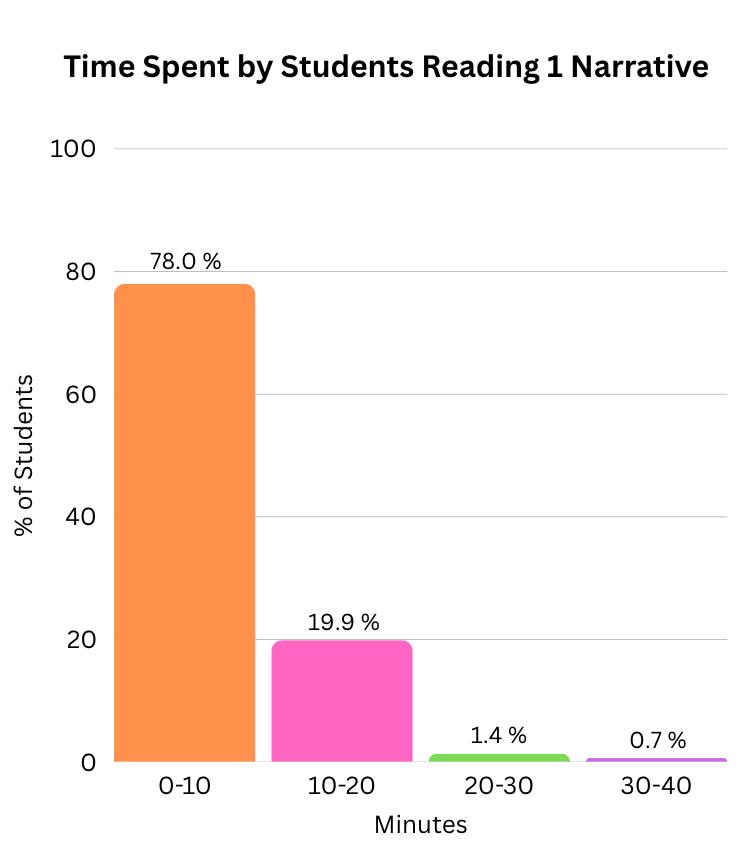


By Senna H. Staff Writer
Hayes S.
I
n July, Hayes will be immersed in the Alaskan wilderness, trekking through Denali National Park with just a backpack and his passion for the wilderness.
He’ll start in Anchorage to begin a month-long expedition with the National Outdoor Leadership School (NOLS), a nonprofit organization focused on wilderness education, cultural immersion, and leadership development. The organization offers diverse programs like “horsepacking” in Wyoming, rock climbing in the Rocky Mountains, and even cultural literacy and community service in Tanzania. Hayes’s course in Alaska emphasizes off-trail backpacking and navigation— without the help of technology, running water, or even trails.
“One of the coolest things I’ve read up on is navigation by trees. There aren’t really trails [or] set paths,” Hayes said. “Towards the end, we’re going to be able to do our own navigation without adults.”
The sophomore is an avid hiking and nature enthusi ast. Last year, he went on a seven-mile hike every weekend, and this year, he’s been enjoying running four times a week and increasing his mileage in prepa ration for the trip.
In Alaska, where he’ll have to set up and take down camp and sleep in open tundra areas, he’ll be venturing into
completely new territory.
“I have limited experience backpacking, [but] this is why I want to go in the program,” Hayes said.
He was also drawn to the experience because of his love of nature and botany, which intersects with his passion and talent for painting. He’s planning on bringing a mini watercolor set.
“I especially love painting outdoors. It’s a whole different experience,” Hayes said. “A lot of my inspiration comes from plants that I learn about, plants that I see, [that I] then wanna paint. [I love] the different concepts and symbolisms behind plants.”
Kyle W. Kyle is diving into one of biolo gy’s most persistent mysteries—the brain. As an intern at Stanford’s Haroush Lab, Kyle will be studying how Hanuman monkeys make decisions in social situations based on neural activity.


He’ll study data from implanted electroencephalograms (EEGs) on monkeys’ neural activity during social games like Prisoner’s Dilemma—a scenario in which two individuals acting in their own self-interest both end up worse off than if they had cooperated.
These experiments ask whether monkeys, like humans, can anticipate another’s choices and open the doors to new questions: do these predictions change over time? If one monkey is betrayed by another, how do that monkey’s choices in the future shift? How is that reflected by brain activity?
To answer these questions, Kyle is combining linear algebra and coding to analyze complex brain data.
“What really drew me to this lab was that it was a beautiful intersection of mathematics, specifically linear algebra, and data analysis, which is very coding based, but also biology [focused],” Kyle said.
This opportunity will allow him to build on past skills while also offering him a look into a new field of study.
He’s excited for all of the new skills he’s going to learn this year and how they apply to future pursuits.
“The skills I build up in data analysis, I’m 100% going to use in the future,” Kyle said. “I’m really excited to look for ways to apply that in the future, but also the interest and knowledge that I get in the neuroscience fields or the overall like biology fields.”
Juliet C.
For Juliet, biology isn’t just a class—it’s a calling. Ever since her first course in middle school, she’s been fascinated with the inner workings of the brain.
Last summer, she interned with a neuropathology professor at University of California San Francisco (UCSF), researching frontotemporal dementia by sectioning mouse brains and using immunofluorescent staining to highlight specific proteins, among other techniques. This summer, she plans to continue working with the same professor at Washington University in St. Louis, Missouri. Immunofluorescence staining works by soaking the brain sections in different biological agents that use specific antibodies to visually color the target proteins. Under
a confocal microscope, they can see these proteins illuminated and analyze patterns of expression in the brain. Last summer, the lab was studying frontotemporal dementia by looking at the effect of genetic mutations in mice and tracking changes in their brain pathology.
This year, she’ll spend a month doing hands-on work in St. Louis before returning home to process and analyze the data she collects. Having taken a data science and programming course, she plans to use those skills with her expertise from last summer for her work in St. Louis.
“I’m very excited to go,” she said. “It’s a good mix of lab work, research, and coding.”
Juliet’s passion for this internship also stems from a personal perspective–her mother is a neurologist, and she is considering follow ing a similar path.
“Neuro degenerative disease is not something that’s been treated or cured,” Juliet said. “I want to make an impact.”


F
rom a bird’s eye, the Rosenberg has turned from a lawn into a swarm, with students slowly rotating around dozens of tables. The September sun is bearing down on the decorations, snacks, and eager club leads trying to get you on their mailing list: no promises or obligations, just a wave of opportunities.
For freshmen, the Clubs Fair is a showcase of the manifold possibilities of the Upper School, and each club is eager to bring newcomers up to speed. But while freshmen are able to learn each club’s interests and goals, they can never definitively know the club’s life expectancy.
A recent anonymous survey of 145 Upper School students conducted by The Current in conjunction with the Statistics and Data Science electives shines a light on that question.
Based on the survey’s self-reported data, the average Nueva student signed up for 5.3 clubs this fall with the intention of regularly attending 3.6 of them. By the end of the year, however, the average student attends only 2.1 clubs on a regular basis.
When it comes to why students choose
By the end of the year, however, the average student attends only 2.1 clubs on a regular basis.
to sign up for the clubs they do, students cited various reasons:
“[I] joined clubs because I thought they would be a fun place to expand my hobbies,” said one sophomore.
“[My] main reason for joining was because friends ran them,” said another sophomore.
“I lead all the clubs that I’m a part of! Maybe it says something that I’m not a part of any clubs that I don’t lead,” said a junior.
“Other than those I already knew I would sign up for, all the new clubs I joined were just ones that bribed me with food,” Etienne Y. ’28 said.
“I stumbled in on a club one day and felt guilty about not returning, so I kept coming,” another freshman admitted.
On Sept. 11 this school year, 44 new clubs debuted for the first time at the Clubs Fair. Clubs are born relatively easily: filling out a single form and setting up a table at the fair is often all you need to get dozens of members. But the death of a club is far more complicated.
While many clubs cease to be active within a single school year, others go through much slower processes of rise and fall.
The demographic trends of countries are often depicted using a population pyramid. Countries with bottom-heavy pyramids can anticipate future growth and a large working-age population. When the pyramid is inverted, the country faces an eminent wave of demographic and economic decline.
Clubs can be understood in a similar way. Those that retain large groups of underclassmen will become new staples of the Nueva
experience, while clubs maintained by a small group of seniors or juniors are likely to vanish.
What are clubs doing to address their long-term futures? What differentiates the startups from the institutions, the old from the new, and the thriving from the withering? Looking to a wide variety of clubs for examples, certain commonalities of the club experience at Nueva emerge.

DATAS (Discussions and Talks
About Science), the producer of Science Friday, may well be one of the oldest clubs at Nueva. Spearheaded by former biology teacher Luke De in 2017, it has become not just a club but closer to an institution.
After De, who had encouraged his students to join and present, left Nueva in 2023, the pool of potential presenters for the club started to dry up. Attendance at weekly Science Friday presentations has fallen for two years straight.
Co-lead Andy M. ’26 sees the long-term trouble for DATAS as emerging, in part, from an overall tendency to prefer starting new clubs over maintaining existing ones.
“There’s an emphasis on being a leader,” Andy argued. “People would rather say they co-founded and led a club versus essentially being inducted into an already established one.”
Max K. ’26, who is in leadership for DATAS, Queer Student Union, and Robotics, has seen another trend across the groups he leads.
“There are fewer freshman sign-ups. I don’t know if that's a cultural shift from previous grades or if it's that our current crop of upperclassmen are failing to lead these clubs,” Max said.
This year, the Science Friday process has changed in response to the increasing pressures of maintaining the club. The review system for presenters has been streamlined, with Review Pairs replacing the large, hardto-schedule Review Teams. Club leadership has focused on increasing outreach to potential members and presenters.
But if institutional clubs such as DATAS continue to fade in favor of transient startups, their unique value will fade with them.
“Often the events that these longer running clubs put on are more high quality, more fleshed out, and have more experience behind them,” Andy said. “It’s very sad for me to see these clubs, which I love dearly, dying off.”

Environmental Club mirrors DATAS in terms of on-campus prominence and sheer longevity, though it faces a sunnier outlook for the near future.
The club’s membership is above average, and drew 22 people to its final meeting of the year on May 21. Its presence can be felt well beyond its meeting spot in Room 1105. In addition to the annual Eco-Action Raiser and Earth Day WOWs, the club expanded its programs this year with an inaugural Waste Audit and the start of a Pre-K Partnership.
For club co-lead Justin C.-B. ’26, the variety of opportunities the Environmental
Club provides is part of the appeal.
“I think we enable people to work on what’s interesting to them. We have people who are focused on policy, on reducing waste, or on programs like working with the Lower Schoolers,” Justin said.
While weekly meetings regularly include presentations or guest speakers, the main appeal for many members is the work done outside of the meeting time.
“One reason why we get a lot of club retention is just because the work we do is impactful and rewarding,” Justin added.


Systema, which partners with local under-resourced schools to provide STEM education opportunities, was among the 44 new clubs founded this past year. The club boasts around 20 active members according to Wendy E. ’26, who co-founded the club with Isabel Q. ’26 and Anika G. ’26.
“Isabel and I both came from pretty big public schools that didn’t have STEM resources,” Wendy said. “Being at a place like Nueva now gives us so many resources and opportunities that we could share with other students.”
Systema, which holds active partnerships with Peninsula Bridge and three local middle schools, is not the only externally-focused, mission-driven club at Nueva. But why do these student-run organizations choose to take the form of a club?
“Even though it's a large idea of bridging the gap between the gap of underprivileged students and STEM, an organization is a lot more intimidating to join, while a club is much more accessible,” Wendy explained.

Youth Design Impact, which provides free graphic design assistance to non-profit organizations, was. The club’s attendance has stabilized at three students, down from six at the first meeting in September.
Grace B. ’26, who founded the club as an extension of her sophomore quest, doesn't view the small membership as an issue.
“I saw how design can help how people feel towards their organization, so I started the club because I couldn’t do it alone,” Grace said. “I expected the membership to whittle over time.”
This year, the club has worked with 15 non-profits, saving them over $60,000 based on the volunteering website Catchafire’s cost estimates of hired graphic design.
Like many young clubs, Youth Design Impact faces an uncertain future upon its founder’s graduation. For Grace, the club’s continuation beyond next year will be up to its junior members.
“It’ll be up to them. Even if it stops
being a formal club, I know it’s something I want to keep doing.”

Board Game Club, founded in 2019, is currently led by Liam P. ’26. The club draws a group of five to ten people, almost exclusively juniors, to its Friday afternoon meetings.
The time a club meets is often vitally important to its long-term future, as Liam can attest.
“10th grade was a low low, and then 11th grade got a lot better just because of the timing,” Liam said. “It was the difference between doing it during Tuesday lunch versus after school on a Friday.”
With extracurriculars taking up students’ afternoons and advisory filling two lunches a week, Tuesday lunch has long been a crowded time period for clubs to meet. With so much competition at a single time, club attendance is inevitably fractured across the board.

While most clubs orient themselves around a common interest or mission, others—such as the Sandwich Club or Cheese Club—serve a different purpose. These clubs offer a social hall to spend time in, regardless of whether or not you’re eating the cheese.
Nonetheless, the two-year-old Cheese Club has gone on hiatus this semester, though its leadership expects it to return in some form next year.
“We just got swamped with work,” said club lead Max K. ’26. “Cheese Club existed because it was not a huge burden on myself and the other leads to run and it brought us joy. Once people stopped showing up as frequently, and once it started becoming more and more of a burden to run, we needed to reframe it.”
Cheese Club faced the additional challenge of having moved its time from Wednesday afternoons to the coveted Tuesday lunch spot, which strained turnout.
Story by Niam K. Staff Writer, Natalie L. Managing Editor & Kayla L. Opinion Editor
Additional Research
by
Justin C.-B. & Natalie C.
Upper School students and administration discuss experiences and perceptions surrounding underage substance use and Nueva’s harm reduction drug education
K
etamine, MDMA, and marijuana aren’t typical high school curriculum topics. Yet, at the end of April, drug education instructor Rhana Hashemi and Colby D. co-presented to the senior class on harm reduction strategies for recreational and illicit substances.
Given his grade’s imminent graduation, Colby researched and shared fact-based information on substances commonly found on college campuses.
“Drug use in a lot of high schools is very normalized, but it’s also something that people are very misinformed about, so I wanted to make a lesson on this,” Colby said.
Colby and Hashemi also aimed to destigmatize conversations about substance use. In their presentation, they encouraged students to “think communally” about how their choices can influence one another.
“Your energy and etiquette affect others,” Hashemi said during their presentation. “The goal is not to preach abstinence or promote drug use—it’s to prepare you [students] to make intentional decisions.”
In discussions about underage substance use, people often cite peer pressure and a child’s environment as two main culprits of how they perceive and engage with alcohol and drugs. However, understanding how these influences play out in a high school setting can be complex.
Hashemi points out that peer pressure isn’t always overt or even intentional. Sometimes, students are influenced simply by their perception of what’s considered normal among their peers.
“When teens—especially younger ones— believe that ‘everyone is doing it,’ they’re more likely to ignore their own instincts,” Hashemi said. “They may override their personal judgment to conform to what they think is normal.”
A recent survey, conducted by The Nueva Current, Justin C.-B., and Natalie C., explored Upper School students’ perceptions of substance use among their peers.
144 student respondents, evenly distributed across grades, estimated on average that 27.7% of Upper Schoolers had consumed one or more alcoholic drinks in the past month. For marijuana use, students’ average estimate was 15.6% of the student body.
A survey asked 144 Upper Schoolers to estimate the prevalence of drug use by other students: of the student body used marijuana in the last 30 days

Respondents guessed that... 27.7% of the student body consumed alcohol in the last 30 days
15.6%

VISUALIZATION BY JACKSON H.
Interestingly, Upper School students assume a smaller proportion of their peers are using substances than found in the 2024 Monitoring the Future survey. In that national study, 10th grade respondents estimated that 50% of their classmates had used alcohol and 41% had used marijuana. This pattern of overestimation was also observed among 12th graders.
However, both of these perceptions are higher than findings from the 2024 Monitoring the Future survey, a national survey on adolescent substance use behavior. For instance, 11.3% of 10th graders self-reported consuming alcohol and 9.5% reported consuming marijuana in the past 30 days.
Some students anonymously share the factors they believe contribute to an inflated perception of their peers’ substance use habits.
One student shared that one specific experience made him think that underage substance use was more common than he initially believed. He recalled a sports teammate who was accepted to a Top 10 university but seemed to use marijuana after school.
“I saw all of my older friends doing it,” he said. “I’m watching these kids who are going to great schools, but then they’re also smoking every single day.”
Others share how their perceptions of substance usage at the Upper School can have been shaped by indirect exposure, such as what they hear in hallways or see on social media.
One student, who considers herself socially distant from anybody who uses substances,
shared how simply overhearing experiences and stories related to substance use made her rethink her views.
“At the beginning of high school, I definitely viewed substances like marijuana differently than alcohol. I used to think: ‘why would anyone do that?’” said the student. “I still think I’ll choose not to do it for a long time, but now it doesn’t change the way I interact with people who do.”
Given the perceived and anecdotal presence of substance use among some Nueva students, the school administration is intentional about providing comprehensive drug education, maintaining a substance-free campus, and offering resources for all students in the case of substance misuse or abuse, according to Upper School Division Head Liza Raynal.
Like with Colby and Hashemi’s presentation to the senior class, Nueva’s drug education aims to provide students with detailed, nonjudgmental information. Topics covered over four years include the effects of substances on brain health, the stages of substance use from experimentation to addiction, how to support a friend struggling with substances, and strategies to minimize risk if engaging with substances.
Hashemi pointed out the importance of a harm reduction-based curriculum.
“In a traditional abstinence-only program, the only acceptable option is to not use—which just isn’t realistic for the wide range of situations teens find themselves in,” Hashemi said. “Worse, it can be life-threatening if students are left without critical information. Harm reduction fills that gap.”
One student recounts learning the recovery position, a first aid maneuver used for uncon-
“When teens—especially younger ones—believe that ‘everyone is doing it,’ they’re more likely to ignore their own instincts,” Hashemi said.
F aculty and students reflect on the implementation of the homework limit at Nueva
Math teacher Kathy Paur uses a simple survey to gauge her students’ workload. The form asks one question: How much time did you spend on the homework?
“I want each kid to spend about 20 minutes on homework. So if the form tells me I’m hitting that mark with all but one student, then I can talk to that student to come up with some strategies and figure out what’s going on,” Paur said. “Or if there’s a really heavy [assignment] represented in the survey, then I learn my lesson there.”
In her planning, Paur also considers the age makeup of a class, whether it is a core or elective course, time given for classwork, and the school’s general guidance of 30–45 minutes of homework time per class.
Though the allotted homework time is a guideline from administration to teachers, each discipline applies it differently.
Allen Frost, English department chair and teacher, described the general difficulty of taking students’ different reading speeds into account with the 30–45 minute limit.
“What takes one student 30 minutes to read will take one student a lot less, or a lot more time. So it’s really difficult to run a class if I just say: everybody, spend 30 minutes on the reading,” Frost said.
Still, to make sure his students have a manageable workload, Frost has surveyed his classes for their reading speeds with in-class reading time. At times, he’s given some choice in the amount of homework—assigning between two or three chapters of reading, for instance. By contrast, CS teacher Matt Hesby does not worry about the homework limit, as he doesn’t
assign any homework in any of his classes, and never plans to.
“There are places and times that homework is really helpful, in certain subjects and populations,” Hesby said. “But in my classes, my worry about assigning homework is that it’s basically saying: here’s a bunch of things I expect you to learn from, but without somebody who can actually support you in doing it. And I don’t think that’s particularly helpful.”
To Hesby, that lack of direct mentorship can disrupt learning. For instance, he believes that simply setting up a tutorial is a better use of time than if a student spends several hours laboring over code on their own at home, stuck and confused. Accordingly, his classes are scheduled with several work periods such that students who use their time effectively are able to meet the expectations of the class.
“All the same, I’m aware that students continue to work on their projects outside of class and I hope they feel productive and successful when doing so,” Hesby said.
With these different approaches to homework across disciplines and teachers, every student’s experience with homework varies accordingly across grade, subjects, and semester.
A recent survey conducted by students in the statistics, data science, and journalism classes, investigated how teachers and students approached the school’s 30–45 minute homework limit. For each class, 27 teacher respondents recorded the maximum and average amount of time they expect students to spend on homework, and 76 students respondents submitted the maximum and average amount of time they dedicate to homework.
From this limited pool of respondents, statistical analyses showed no significant difference between teacher expectations and overall student-reported workload.
But while teachers reported assigning homework within the 20–45 minute range, student answers included a variety of outliers on both sides of the spectrum. One student recorded an average homework time of four hours per class, another student reported a maximum of eight hours of homework time, while others described no homework at all. For instance, though Cameron L. does not count the exact amount of time that he spends on each assignment, he has generally found the workload reasonable, and within the limits.
“When you look at the time actually spent working, I think most classes have been good about keeping it manageable, and the homework isn’t too dense,” Cameron said. “When MAs stack up, though, it’s more difficult.”
Similarly, Anika G. defined homework as an important tool for and expanding her interest in a topic. Her workload has fluctuated more, but once she reaches 45 minutes on a single piece of homework she usually keeps on working.
“I’m committed at that point,” Anika said. “Also, I don’t want to go up to a teacher and say I spent 45 minutes, then wasn’t able to finish it.”
Caroline F., since the start of freshman year,
scious but breathing individuals, from Hashemi, and then using it at a county fair to help an outof-school friend. Their friend was prescribed anxiety medication (Xanax) and, not properly aware of how mixing substances would affect his body, consumed alcohol and soon after blacked out. Remembering their training, they placed their friend in the recovery position and called an ambulance.
“[My friend’s] eyes were fully rolling back and he’s throwing up as I’m putting him in the recovery position. It was so scary—I thought he was going to die,” said the student. “If I didn’t know to put him on his side, he would’ve choked on his vomit.”
To Raynal, she believes that quality drug education is essential because schools are the ideal place for students to receive information that safeguards their wellbeing.
“I do think we have an obligation to be a source of good information,” she said. “If you don’t get it from us, then we don’t know where you’re getting it.”
Raynal also highlighted the importance of messaging from administrators like Dean of Students Jackee Bruno before dances or trips, where students are reminded that “major violations,” such as possessing alcohol, yield immediate consequences. She emphasized that the goal is to ensure a positive school experience.
“It’s wanting students to be safe, to make sure that we are maintaining a substance-free campus, and a substance-free experience for students at school,” Raynal said.
At the same time, the Upper School provides materials like Narcan—an opioid antidote—in accessible locations throughout campus, along with crisis hotline signs in bathroom stalls. These resources are in place to prevent harm if students choose to use substances during their time at Nueva and beyond.
Hashemi shares similarly-oriented hopes for the mindset Upper School students gain from drug education and their time at Nueva.
“More than anything, I hope [students] walk away with a mindset that celebrates students who choose not to use, supports those who do in being safe and mindful, and encourages everyone to ask questions and get help without fear of punishment or shame,” Hashemi shared.
has felt that same reluctance to bring up any extra time spent on homework. She alluded to a general cycle of imposter syndrome, fear of not keeping up academically, and consistent disregard for the homework limit that she—as well as friends—have gone through.
“By speaking up about [the homework limit], it might seem like you can’t handle as much as other [students] can,” Caroline said.
That stigma, combined with the wide range of student experiences, makes it difficult to find a one-size-fits-all solution. Despite using surveys to gauge workload and stress, Paur noted that student experiences and attitudes are constantly shifting.
“It’s possible they’ll ask me to clearly mark which questions are not required, and it’s pos-

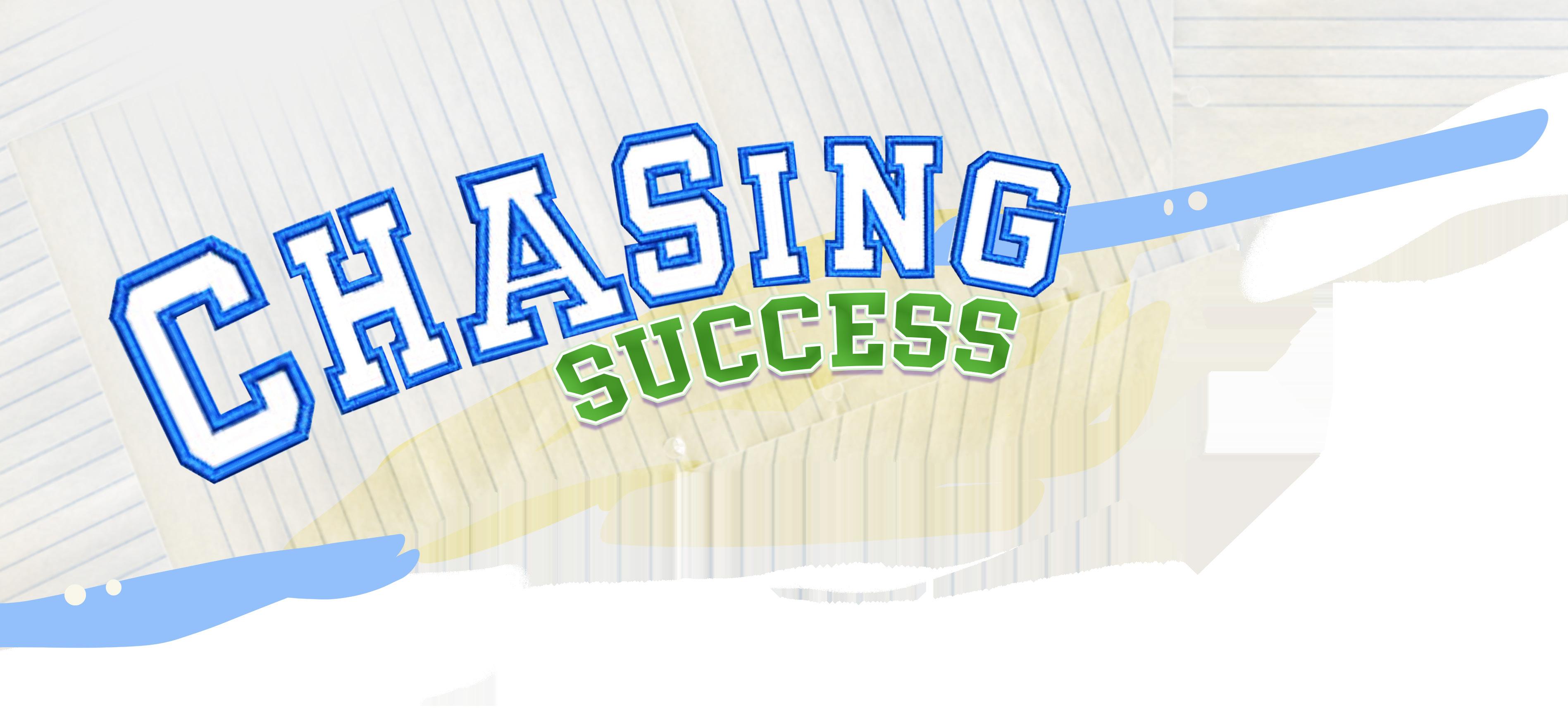
Continued from Page 1
The 47-second Instagram Reel, set to the song “I’ll Always Remember You” by Hannah Montana (lyrics: I always knew this day would come / We'd be standing one by one / With our future in our hands / So many dreams, so many plans), cuts rapidly between seniors displaying college sweatshirts representing Stanford, Brown, Northwestern, and other highly ranked colleges. The video garnered over 300,000 views within three weeks.
Social media posts like these are celebratory, commemorating a significant milestone in the life of a high school teenager. While they serve as a meaningful and joyful marker of achievement, their public nature also makes them easily accessible—and open to scrutinty—from peers, parents, and the wider community. Content like this can feed a narrative that favors students who attend highly ranked schools over those who attend universities that might be ranked lower but align better with their interests and values.
In the same form, survey data shows that 65% of respondents across all grades expressed a belief that attending a highly selective college was important to fulfill expectations that their parents held.
Aryan M. ’25, who will attend the University of California, Berkeley next year, agreed that external pressure from parents to apply to certain schools exists, but proposed multiple reasons for the possibility.
“I know some people whose parents went to one school and really want their kids to go to that same school,” Aryan said. “Or it can go the other way, since [generally] a lot of immigrant parents who may not have had the chance to go to a prestigious school want their kids to.”
He suggested that parental expectations may come from a sort of “self-fulfilling prophecy,” where they see other Bay Area parents celebrating their kids who will attend selective schools, and subsequently compel their own children to strive for that goal.
Ultimately, these influences can reinforce a persistent cycle of self and externally imposed pressure.
“I would say people’s parents have high expectations. I think students [also] have high expectations for themselves,” said Livie P. ’26. “[But] seeing all these students who graduated and have gone to amazing schools has created a sort of atmosphere of, like, ‘I'm expected to go to those schools.’”
College counselor Paul Gallagher explains that Nueva’s college counseling program is designed to be highly personalized and attentive to each student's unique experience. He emphasizes the importance of building close relationships with students to create a supportive environment where influences— whether cultural, individual, or parental—can be recognized and addressed.
“We implement a counseling program that is very individual, so there’s nothing like a forced march through the application,” said Gallagher, who shared that the college counseling team—who also serve as coaches, advisors, and trip chaperones—get out into the community so that they can better know and understand the students they work with. “Hopefully, by doing that, we give students a
relatively safe space for them to admit how they are being influenced.”
Each year, review websites like US News & World Report and Niche generate “best college” rankings. Families look to these rankings as a benchmark, and schools consistently landing at the top become household names associated with prestige. But there is no objective definition of a “top school.”
In spending time researching schools and working through the application process, some seniors realized that rankings weren’t an important factor in selecting the schools they applied to. Survey data indicated that 71% of seniors believed it was important for them to attend a highly selective college, and 48% believed that attending one would be representative of their academic success and value.
These numbers were higher for the other grades: 87% of freshmen, 88% of sophomores, and 88% of junior respondents believed it was important for them to attend highly selective colleges, and 70% of freshmen, 65% of sophomores, and 72% of junior respondents believed that attending one would be representative of their academic success.
Nathan S. ’25 and Leo S. ’25, who will be students at Santa Clara University and Boston University, respectively, found that the meaning of college rankings diminished when visiting and touring the campuses, citing how they realized many schools felt very comparable regardless of selectivity.
“I had a very similar experience and mindset [to the younger students]. I would always look at top-ranked schools,” Leo said when looking at the survey data. “But at the end of the day, they’re all very similar. I find it strange that [ranking websites] are able to find such clear differences between these schools, because you’re going to have a great experience wherever you go.”
Additionally, Nathan pointed out that a school’s ranking is just one statistic that factors in numerous metrics about the school. To him, the specific academic program he was interested in was significantly more important.
“It's a number that doesn't mean that much to me. Because I'm somebody who's interested in STEM, applying to the number one liberal arts school in the country just wasn't that appealing to me,” Nathan said. “I don't think that would serve as a measure of my success or academic achievement, because it's not what I'm looking for.”
The idea of “best” is subjective and can hold a different meaning for every individual.
Lara M. ’25, who will attend the University of North Carolina next year, finds that this sentiment rings true.
“I chose UNC over schools that are ranked higher, or often perceived as ‘better,’ because of the specific program that I’m in and the opportunities that I'm going to get because of that,” Lara said.
Part III: A Nueva Definition of Success
Many selective universities with low acceptance rates clarify in their application process that they consider a holistic review of each applying student. The factors they consider include essay quality, the applicant’s
traits and character, their extracurricular involvement, and academic performance.
In a survey conducted by The Nueva Current last year, following the COVID-19 pandemic, a majority of students received all As in their coursework (81% of grades awarded were flat As) at Nueva. Additionally, Nueva prides itself on its efforts to reduce competition among students. The school does not calculate GPA, track class rank, offer AP courses, or recognize a valedictorian or salutatorian. Still, a competitive mindset can emerge and the effort to stand out from one’s classmates manifests itself in other ways.
“I don’t feel like people are competing to get all As because it’s not an exclusive thing,” said Hannah F. ’27. “But it’s pretty common after a test for people to ask around, like, ‘Did you get this question right or wrong?’ because they want to [compare answers to] know where they stand in the class.”
To stand out from their peers, students can turn to extracurriculars as a way to stand out from their peers. This chase for extracurriculars—sports, volunteer hours, club leadership positions, internships, and more—has some students feeling out of place and concerned about their perceived uniqueness.
“It's hard for me to admit this, but I often feel worried when I hear about my peers' accomplishments,” another anonymous freshman wrote on the survey. “I'm afraid that I will not stand out compared to them through a college lens.”
These feelings of uncertainty and self-doubt aren’t uncommon among students navigating the pressures of college preparation.
“I wonder whether doing extracurriculars at a pace similar to my peers to help improve my resume is something I should be doing,” an anonymous junior said in an interview. “Am I not focused enough on college? Am I too focused on college? I don’t even know.”
Some students feel pressured to try and participate in certain extracurricular activities, even if they may not be as interesting to them as other activities.
Early in his junior year, Carson M. ’26 joined Food4All, a food insecurity nonprofit organization founded by students at Los Altos High School, but he quickly left soon after when he recognized he no longer enjoyed working in the organization.
“I thought it would be a strong addition to the resume and would demonstrate initiative and leadership in a community service setting, which I was missing at the time,” Carson said. “After a few months, I realized it was just a club that dozens of other kids were doing with the same intent I had coming into it, and I needed to start something unique, original that I could claim for myself.”
Carson’s observation of local high schoolers pursuing activities for the sole purpose of checking boxes on their resume is not uncommon, reflecting a broader culture of performative involvement driven by college admissions pressure.
According to the survey, 38.94% of the surveyed students self-reported prioritizing extracurriculars they aren’t as interested in, but are perceived to look more attractive
to admission officers over hobbies or personal interests. When asked to think about other students at Nueva, 92% of respondents agreed with the statement, “I believe that my peers join or have joined activities that they are NOT very interested in because they believe that it will make their college application or resume look better.”
“I think this is a big problem, especially with students in leadership,” an anonymous freshman wrote. “It takes away from the idea of servant leadership and makes the role more self-centered.”

For Carson, the pressure of ensuring that the college resume only contains “desirable” or most impressive extracurriculars leads students to abandon activities or hobbies they once enjoyed. These activities are frequently dropped not because of a lack of interest, but because they’re seen as offering little value to a college application compared to other, more strategic options.
Carson used to be a pianist and loved to play the piano, but he decided that even though he enjoyed playing, it was not worthwhile to continue. He put piano on hold and replaced it with more activities with a higher perceived value.
“I realized at a certain point that I need to be more practical. This is just sucking up time that I don't really have,” Carson said. “I recognized the decision was correct, so I wouldn't say it was something I regretted, but there was a part of me that was a little annoyed. In an ideal world, there are so many other activities that I would be doing and

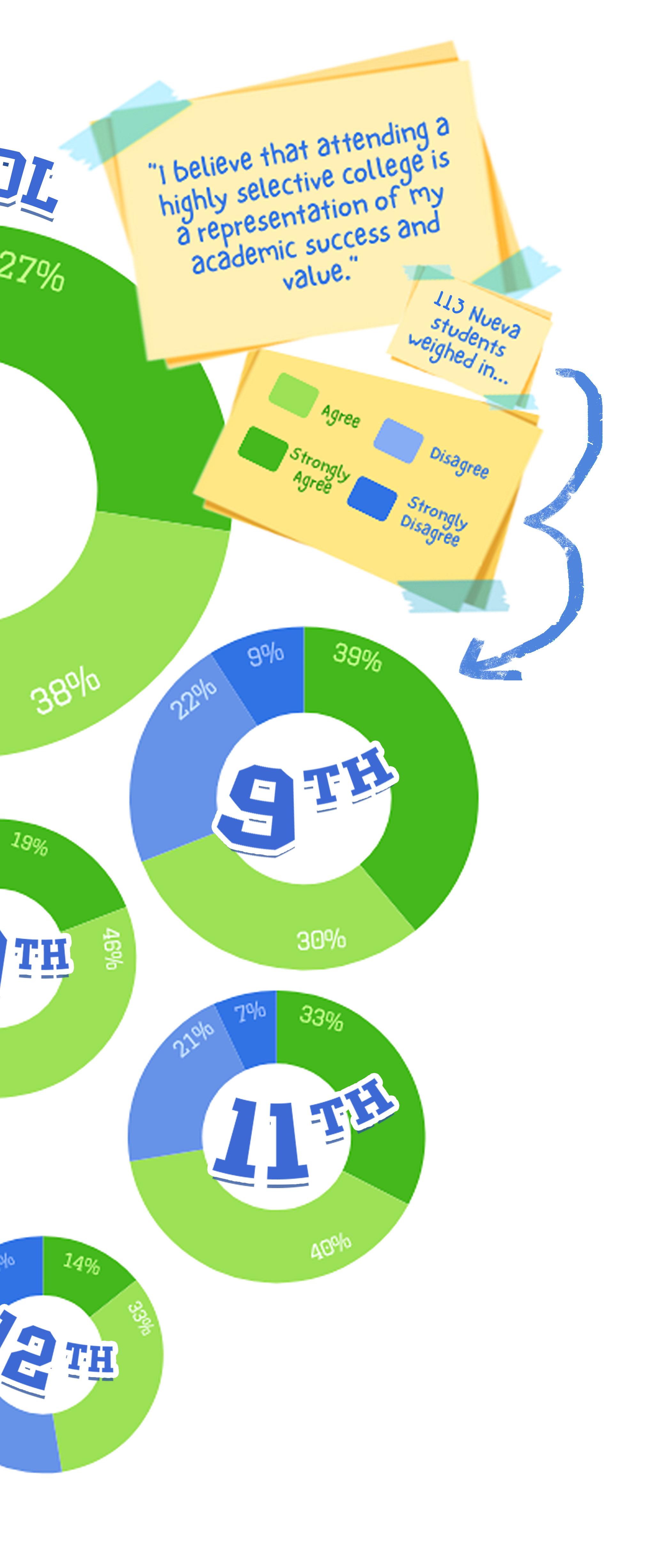
this person didn’t have their own merits.”
In some cases, curiosity around college admissions goes beyond casual conversations and turns into direct, and sometimes uncomfortable, questioning. Lara has experienced this firsthand, with peers approaching her multiple times to express surprise or other judgment about her decision to attend UNC.
“I often wondered, why are they judging me that way?”
Lara said. “But some people have said, ‘Oh, they're judging you because they see a lot from you, so they expected you to go to a 'better school.’’ Or, ‘they're just judging you because they don't understand the value of the school and the program that you're going to.’”
activities that I'm doing now that I would not be doing because they're servicing my passions.”
Part IV: Running Their Race
From self-questioning and the pressure to participate in as many extracurriculars as possible, an uncomfortable environment surrounding the college application process emerges, but remains hidden beneath the surface—often becoming visible when acceptance decisions are announced and peer comparisons intensify.
Connor H. ’26 has noticed tension, jealousy, and judgment among peers during college acceptance season, especially when news spread about which seniors were admitted to which schools. He observed that once someone is accepted into a highly selective university, others begin to scrutinize that person’s college resume, trying to understand what set them apart that they were admitted.
“I remember a person got into a great college through Early Decision, and then I overheard conversations with different people about how they got in,” Connor said. “As soon as people found out, they were talking about it and trying to justify it. Do they have legacy there? What did they do? They were so certain that
balance extracurriculars in school and a bunch of other things, and I couldn't, made me feel definitely like an outlier,” Livie said. “I was different, or made it make me feel jealous of other people in a way, because they’re able to do this and that and still appear fine, and I can only do one thing at once. That makes me feel like it's gonna be difficult for me to get into the colleges I want compared to other people who are doing all these things.”
It’s natural for some students to feel external pressure from peers, leading to resume stacking, self-doubt, and judgment. Despite these challenges, the school takes some exceptional and uncommon steps to minimize academic competition between students: the elimination of AP courses, avoiding student rankings, fostering a curiosity- and passion-driven environment, and having college counselors who emphasize finding a college that fits each student’s personality, interests, and learning styles. At the start of the fall semester, seniors also gather to come up
“At the end of the day, the people around me will always be there for me. I want to be there for them during a time where there might be a lot of stress, whether they want to admit it or not.”
with a collective agreement on norms around the college admissions process, which can include ways to talk—or not talk—about the process. Students appreciate these approaches, which can complement their own individual efforts to mitigate pressure.
around me will always be there for me,” Aadit said. “I want to be there for them during a time where there might be a lot of stress, whether they want to admit it or not.”
In an email to the freshmen class last week with the subject line “Transitions,” 9th grade dean Patrick Berger noted the inevitable stress that can come with the onset of grades and the looming college process. He acknowledged the tension with Nueva values that the addition of grades in 10th grade creates. In his final email to the freshmen, he wrote, “Despite the pressure that can come from grades—and the college admissions process that necessitates their existence, I hope you will preserve ideals such as the importance of each student following their passions, determining their own goals, and being compelled to learn through internal motivation and the intrinsic value of knowledge.”
“Over the next several years, I hope that you will be able to still preserve these ideals despite the pressure that can come from grades and the college admissions process that necessitates their existence,” he continued. “Don't miss your opportunity this final week of the semester to have frank and constructive dialogue with your teachers without the specter of grades looming in the background. Your world becoming more structured over the coming years does not mean the same has to happen to you.”
Rather than letting the judgment affect her, Lara remains confident in her decision, pointing to its strong community, helpful resources, and emphasis on learning—qualities she values more than name or brand recognition of other schools.
Besides peers and family members asking well-meaning but direct questions, the pressure to succeed academically has led some students to distance themselves from friends and devote more time to studying. Livie, for example, has felt the pressure and has begun to prioritize school during her free time to maximize productivity. While she made the decision to focus on academics with college admission as her goal, she still often feels overwhelmed by her decision.
“Feeling like other people could
Aadit B. ’26 tends to focus on his own work and goals rather than comparing himself to his peers. By practicing “gratitude,” he feels confident about his accomplishments; instead of comparing himself to the people around him, he minimizes feeling the competitive atmosphere intertwined with college applications.
“At the end of the day, the people

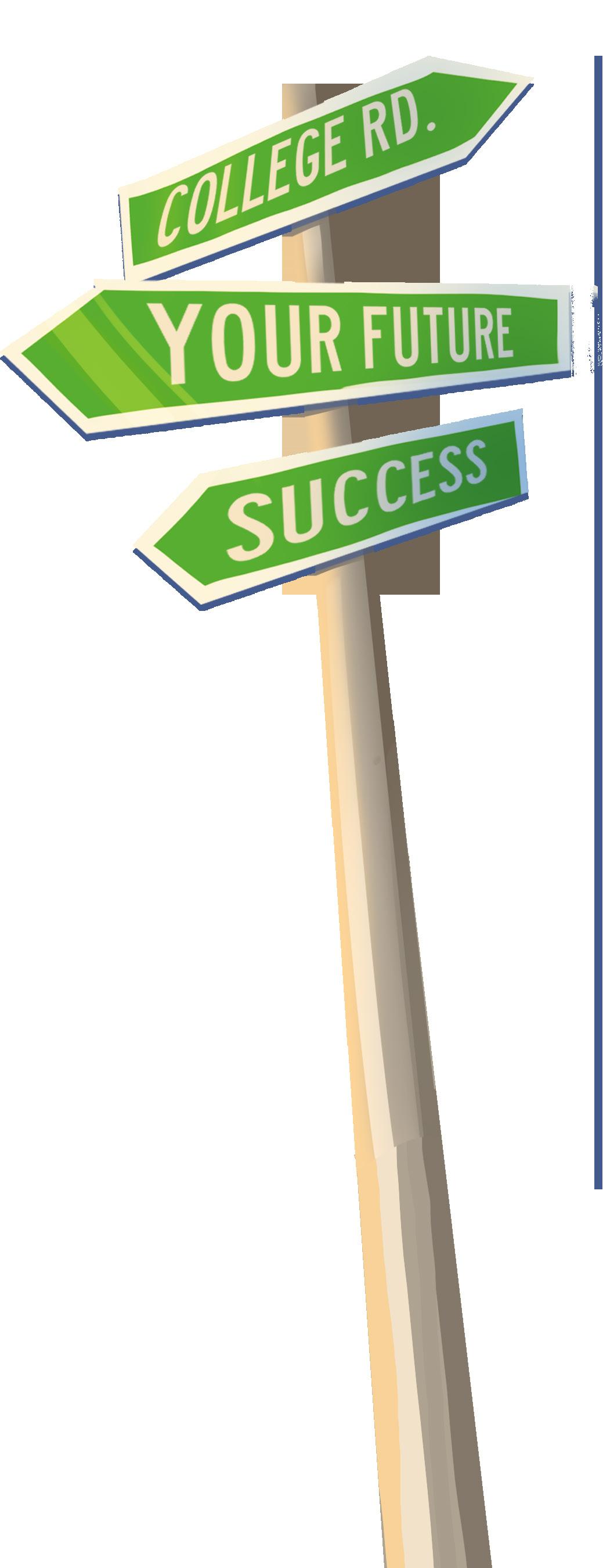
Story by Anwen C. Staff Writer & Jackson H. Additional Research by Eleanor A. & Jackson D.
E
very young generation is told that they have the power to change the world, and Gen Z is no different. Connected, outspoken, and empowered by technology, we are seen as the ones who will reimagine a more just, equitable, and sustainable future.
But to take the baton of changing society requires a sure footing, and the world Gen Z is set to inherit is proving to be anything but stable. Every day brings a new urgent headline, global alliances are breaking apart, climate change is intensifying, and political polarization grows more entrenched. How can a school prepare students for their future in the “real world” when the shape of that world is increasingly uncertain?
In a survey conducted by The Nueva Current and members of the Data Science and Statistics electives, 114 student respondents reflected on topics ranging from personal goals to the world at large. Responses were mixed, to say the least.
Optimism cannot be assessed from a binary lens. It can’t be reduced to the classic “glass half full” or “half empty” question— as if one’s entire outlook could be summed up by a single measure of hope or cynicism. In reality, there are a dozen different glasses on the table.
A student may be optimistic about their college readiness and future career, but may simultaneously be worried about worsening climate conditions or growing political divides.
“I feel hopeless about a lot of things politically, but I also feel hopeful about things like research, science, and activism,” noted one anonymous 9th grade respondent.
Optimism is a layered subject—and it should be treated as such. Rather than labeling someone as an “optimist” or “pessimist,” it’s more accurate to recognize that their outlook reflects a mix of often conflicting concerns.
Optimism cannot be assessed from a binary lens. It can't be reduced to the classic "glass half full" or "half empty" question.
Politics, in particular, brought out the strongest feelings from the student body. Across grade levels, students were generally united in their distaste for American politics today, with 79% expressing pessimism for the country’s future in the next five years.
Most, however, trusted in what they were personally able to control, with 73% saying they were confident in their ability to bounce back from future setbacks. When asked about their life after high school, 77% of seniors agreed with the statement “I feel ready to take on the future as I head into college,” while only 5% disagreed.
The picture becomes more murky when one’s own life intersects with broader changes in society.
42% of students agreed with the statement “I worry the work I do in my professional life will be meaningless or unsatisfying,” while 46% disagreed. Artificial intelligence is one major destabilizing factor for the future of work.
“Historically, automation has been used as a lever to cut down
on costs to the point where people cannot survive on wages,” said Max K. ’26, who personally disagreed with the question on the form. “I believe AI is the next step in that process.”
For others, the root of modern dissatisfaction with work is a lack of agency in how we work, not just what we do.
Gen Z has grown up alongside the rise of a disruptive technology sector that seemed

poised to reshape our relationship to labor. But for some students, that promise feels hollow: while job titles and industries have changed, they worry that the larger structures behind them will persist.
“I don’t really think we have opportunities to decide how we want to
engage with work or leisure,” said Lily Z. ’28.
Others are determined to avoid mundanity in their future work. Lila P. ’26, who is interested in the nonprofit sector, sees a meaningful career as a requirement for her, rather than a nice-to-have. She sees that same motivation in many of her peers.
“I’m surrounded by a lot of privilege, where I’m lucky enough to get to do the things I enjoy,” Lila said. “A lot of the people I’m surrounded by are excited about what they do.”
The uncertain future of work is an additional challenge for schools which, in part, serve the purpose of preparing students for professional life.
“I don't think there's a unified message from Nueva on what a successful career looks like,” Max said. “I think that is something that Nueva tends to do very, very well is allow for a diversity of what we want to do with our lives.”

But when asked to look beyond vocation to their personal aspirations, respondents’ doubts became even more prominent. Among those surveyed, 52% agreed with the statement “I worry that my personal goals may be unrealistic in today’s world,” while only 24% disagreed.
"I don't really think we have opportunities to decide how we want to engage with work or leisure."
In a world marked by rapid and unpredictable change, dreaming big can feel naive. Students increasingly feel they are navigating a world that resists meaningful change.
The question for Generation Z, then, is not just whether we want to change the world—but whether we can. Will our generation be defined by the inertia of our predecessors, or by our determination to overcome it?
Few issues capture this tension more clearly than climate change. For Gen Z, the prospect of climate catastrophe is not
urgency and imagination.
The survey’s responses suggest cautious optimism. When students were asked whether they believed their generation would be more socially and environmentally responsible than previous ones, 54% agreed.
“We don't have a choice, at least environmentally. We just can't give up,” said one anonymous 11th grade respondent. Others believed similarly in our capacity to adapt and rebuild. “The general pattern of history and social progress gives me hope, and I’m surrounded by very socially active people,” Lila said.
But even as some students spoke with optimism, others questioned whether hope is enough for an issue as existential as climate change.
“A lot of optimism comes with the belief in individual agency, which I don't really think is the case [for the climate],” Lily noted.
Whether it’s the next academic year or the next global crisis, one thing is clear: there’s no single mindset that defines Gen Z. Some of us are hopeful, others more skeptical—and most fall somewhere in between.
We may not be the half-full generation, but we’re not empty-glass either. We’re simply the ones holding it, figuring out how to carry it forward.

By Alexis C. Staff Writer
Nueva, here's a peek into the next four years of their journeys.
4 new colleges At a
3 are being attended (DePaul, Notre Dame, CU Boulder, and Rider University)
GapYear x3 seniors are taking a gap year
50 Colleges being attended, in total
Mascots
The most common are bears (4) and big cats (4)

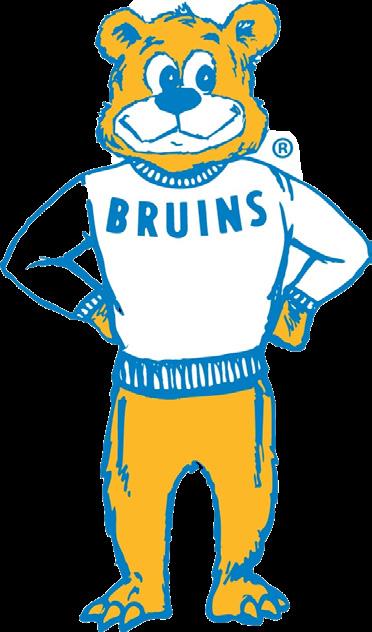
By Josie B. Editor in Chief & Natalie L. Managing Editor
Dear The Nueva Current,
Walking into the portable classroom in ninth grade, I remember being slightly horrified at the setup of LiAnn’s journalism class.
1. Unlike my other classes (and all the other classes I had taken at Nueva for the past 10 years, for that matter), this class had only four freshmen and a sea of students from other grades.
2. I immediately had to share (read aloud) my writing with an entire class of strangers.
Thank goodness, I was too intrigued by the group of people, the teacher, and the work to warrant a course change request. As much as they intimidated me, these features turned out to be some of my favorite aspects of journalism. Meeting people from other grades, while intimidating at first, provided me with mentors who taught me, supported me, and encouraged me to persevere, even when I doubted myself. Sharing my writing taught me to embrace the editing process, be vulnerable with my peers, and trust in my voice (even in a time crunch!).
As I prepare to say goodbye to the school I grew up in, I feel incredibly grateful for all that The Nueva Current has given me during my high school experience. It has been a community I can always count on, no matter how it changes. It has been a way to meet and get to know so many people at the high school whom I wouldn’t have otherwise, and learn about their lives.


It has been the class I look forward to every single week. And, finally, it is the reason I discovered a passion that I plan to pursue in college and beyond: journalism.
It’s always bittersweet to say goodbye to our senior editors. I imagine our incoming team of editors may feel that way now, as Natalie, Gabriel, Ethan, and I prepare to pass on the torch. But I couldn’t be more proud of the new editors and staff. You are all so capable, thoughtful, and ready. I’m genuinely excited to see what you do next. Thank you for everything, TNC!
With love,
Josie B. Editor in Chief
Dear The Nueva Current,
Earlier this semester, our journalism teacher, LiAnn, had us read an opinion article published in the New York Times headlined “Elite College Admissions Have Turned Students Into Brands.”
As we read it, my morning sleepiness quickly faded. The guest writer’s critiques of how admissions officers define standout students struck a chord with me.
“The smart student boils down key aspects of himself or herself into their personal ‘brand’ and sells that to the college admissions officer,” the article wrote. “Instead of finding their passion and values through experience, students are encouraged to select a passion as early as possible and then rack up the experience to substantiate it.“
The phrase—personal brand— exactly captures a pressure I’d felt since freshman year and am trying to unlearn: the need to create a version of myself so consistent and marketable that, many times, I’d asked how an extracurricular might contribute to my overall story before even joining it.
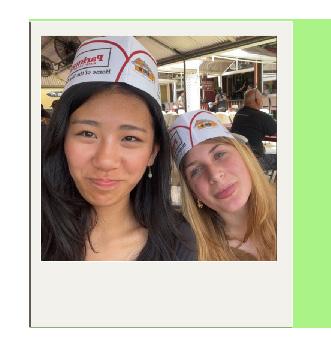
As embarrassing as it is to admit, that mindset also influenced my decision to join The Nueva Current in freshman year. I came into the Upper School convinced I’d pursue Political Science (probably false, given that I’ve been accepted into college as an intended Biology Major)
By Kayla L. Opinion Editor
with no real reason other than some early luck in debate tournaments.
At that time, I didn’t really stop to think if humanities was what really interested me. Passion came second to curration, and I deemed that journalism aligned well enough with my supposed academic aspirations.
But once I actually joined, journalism felt like the first real break from that rigid mindset. Even though it’s technically categorized as an English class, it never felt like it confined me to a single identity or interest.
As my academic interests shifted over the years, journalism always remained as an extracurricular that encouraged me to follow my curiosity.
Writing articles lets me investigate a new part of the world every time. I’ve felt blessed for the opportunity to talk to professionals in fields ranging from environmentalism to shoe making, along with learning stories from dozens of Upper School members. The stories I took on were never about building a résumé or a brand.
In fact, I felt encouraged by my classmates to do the opposite and learn something just for the sake of it. In the newsroom, I was pushed to identify the most pressing questions, the most overlooked topics, and show the world, and myself, why they mattered.
Journalism gave me a break from the pressure of curation—it demanded that I be messy, experimental, and honest. For that, I’ll always be grateful for our publication family.
XOXO, Natalie L. Managing Editor
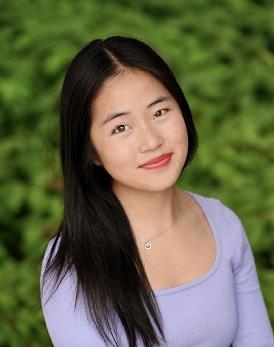
Even if you’re tired, just keep going, my mind reasoned. For weeks, I had woken up sore, tired, and anxious. During the day, I would suppress my stress to go to school and interact with friends on auto-pilot. In the afternoon, I would come home depleted and still tense, leading to embarrassingly grumpy interactions with my younger sisters and parents.
I could feel the stress of my commitments and perfectionism weighing on me. Not to justify the time I got annoyed with my mother for offering me half of an apple—sorry, Mom. Unfortunately for both of us, I incorrectly thought that productivity outweighed kindness to myself and others.
That mentality didn’t support a sustainable lifestyle. Seeking solutions, I made a five-minute addition to my daily routine: mindfulness meditation.
I initially doubted the habit’s efficacy, as I had sworn off the repetitive inhales and dreary exhales years ago, when my elementary school guidance counselor poorly introduced meditation to me.
Yet, as I attempted it with an open mind, meditation improved my mental health and allowed me to be more mindful. That mindfulness doesn't just affect how I feel internally, but ripples beyond: how I treat others, how
That mindfulness doesn't just affect how I feel internally, but ripples beyond: how I treat others, how I consume food, and how I talk to myself.
I consume food, and how I talk to myself.
The benefits of mediation that I’ve experienced are gratifying, especially for the little time I spend on it each day. I open a free meditation app I downloaded called Medito, choose a five-minute meditation, and then concentrate on being mindful of the sounds and sensations around or within me.
The tiny time commitment doesn’t necessarily mean that the practice of meditation is easy. Some days, I lose focus two minutes into a session and don’t reap all the benefits I hope for. I often revert back to old habits and stressors when I miss multiple days or weeks of this mindfulness practice. Meditation is not a silver bullet. I took Medito’s 30-day beginner course, which contains much longer meditations, before
switching to the shorter daily ones, and building the skills to meditate challenged me. The inclination to fidget was definitely something I needed to overcome, making me realize that meditating for even just five minutes can be difficult.
In other words, I’ve learned that meditation isn’t a self-care technique in the sense of taking a bubble bath or binging Netflix. It takes work and discipline—which ironically was the very thing stressing me out. But dedicating myself to meditation ultimately enabled me to understand that we don’t live to work. Instead, we work to live—and to be in thoughtful, attentive presence with everything around us.

The Nueva Current
Volume 8
Masthead
Josie B. ’25
Editor-in-Chief
Natalie L. ’25
Managing Editor
Alvin Y. ’26
News Editor
Gabriel B. ’25
Features Editor
Ellie L. ’26
Culture Editor
Kayla L. ’26
Opinion Editor
Ethan H. ’25
Sports Editor
Alexis C. ’27
Jackson H. ’26
Web Editors
LiAnn Yim
Faculty Advisor
Staff
Anwen C. ’26
Emily F. ’27
Jordan F. ’27
Neel G. ’27
Senna H. ’26
Niam K. ’26
Anvi M. ’28
Natalia R. ’28
Senya S. ’26
Callum S. ’27
Alexandra S. ’28
The Nueva Current strives to provide informative and impactful articles for our community. Our issues cover stories related to our school, the Bay Area, California, and other relevant spheres. We are dedicated to helping readers understand the ways in which we can all make a difference in the world around us.
The opinions expressed in The Nueva Current belong solely to the writers and are not a reflection or representation of the opinions of the school or administrators.
The Nueva Current is distributed to current and alumni members of The Nueva School community. Press run is 600 copies, printed by FolgerGraphics. Fonts used in Volume 8: Very Vogue, Seriously Nostalgic, Awesome Font, Glamour Absolute, and ITC Galliard Std.
The Nueva Current is a member of the NSPA and CSPA. NSPA Pacemaker Finalist 2020, 2022, 2023. Pacemaker Winner 2022. Gold Crown winner 2023.
QUESTIONS, COMMENTS, SUBMISSIONS
We welcome your voices. We accept photographs, letters to the editors, articles, illustrations, and other pieces of work. Please email us at thenuevacurrent@nuevaschool. org.
STAY CONNECTED
www.thenuevacurrent.com
Instagram: @thenuevacurrent
Twitter: @thenuevacurrent
131 E. 28th Ave. San Mateo, CA 94403
When we sacrifice experiences for logistics, we lose what makes education memorable.
By Callum S. Staff Writer
Encores shouldn’t be before the final song. Trips week was our academic finale, now they’ve made it an intermission. Rescheduling trips hasn’t just changed dates on the calendar—it's contravened the essence of a Nuevan curtain call.
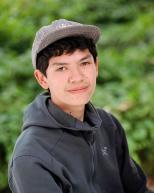
For years, trips week has mastered an artful rhythm; that light at the end of the tunnel, a golden finale where backpacks shed the weight of laptops and folders for clothes and passports. Afterwards, students would return to low-stakes assignments, classrooms buzzing with that end-of-year ease when even the most austere teachers stop counting tardies.
This year’s rescheduling has shattered that rhythm. Trips week landed in April with all the grace of a brick through stained glass windows. Students boarded
return flights with a mountain of tests and essays looming, with some even bringing laptops to finish overdue assignments.
Having spring break the following week offered brief respite, but it couldn’t mask what was to come: five weeks of uninterrupted school—a period so long that students and teachers alike struggled to recall a longer stretch.
Conversations abroad tilted inevitably
Trips week at its best wasn’t just a trip, but it was how students remembered their year.
towards the deadlines and grades that menacingly embraced our arrival. What is the prompt for the upcoming essay? Is the test on the first day back challenging?
Light at the end of the tunnel? No. Another train herding us towards the next Major Assessment.
Next year's “fix” of wedging three school days between trips and spring
It’s time to tune into local news
The Nueva Current welcomes comments and suggestions. We seek to publish corrections and clarifications in the subsequent issue. Please email any corrections to thenuevacurrent@nuevaschool.org.
break misses the point. Those three days might look reasonable on paper, but they will satisfy no one, not students mentally on break or teachers scrambling to figure out a lesson plan for a half-empty classroom.
Administrations' considerations, from PSAL playoffs to airline costs and rising seasonal weather patterns, are understandable. But, looking ahead, we must ask if these practical concerns outweigh the emotional value of a genuine ending. The mid-May timing carried magic; a segue into summer, the collective exhale from a community completing something meaningful together.
Trips week at its best wasn’t just a trip, but it was how students remembered their year. It was Nueva’s denouement. As we plan future calendars, that distinction deserves preservation.
As Jackee and administrators reconsider the future of trips week, one thing should be clear: trips week must return to May, before this becomes the norm.
Local news offers overlooked benefits in a time where national news is polarizing and corrupt
By Neel G. Staff Writer
In recent years, national publications have bombarded the news cycle with misinformation, biased reporting, and extremely disheartening political events. From the New York Times’ faulty reporting on the Palestine-Israel conflict, to Jeff Bezos’ new limitations on the Washington Post’s opinion section, to President Trump choosing which reporters cover him, national news organizations are at the forefront of the degrading political state of America.

These misreportings and biases have detrimental effects on our political perceptions. When the New York Times, a nationally—even globally—consumed news source, admittingly misreported Israeli responsibility to a hospital explosion in Palestine back in 2023, it misinformed every reader of that article on crucial events in a war. According to former editors, Jeff Bezos vetoed the Washington Post’s endorsement of Kamala Harris after a draft was written earlier this election cycle due to Bezos’ fears of repercussions on his business if Donald Trump were to be elected; this sparked distrust amongst journalists and citizens alike of free press in America, as over 250,000 subscribers canceled their subscriptions and editorial staff members resigned. When the Trump administration announced they will choose the exclusive group of media outlets that report on the president’s activities and information, instead of the White House Correspondents' Association (WHCA) as it’s been for decades, the integrity and objectivity of political journalism was immediately questioned.
As a student journalist, it’s difficult to admit that I, like many others, detached myself from news during election season; it became overbearing and dishonest. But what picked me back up on my feet and engaged back in the news cycle was not the New York Times or Wall Street Journal—it was local newspapers, like the Los Altos Town Crier or Mountain View Voice
However, more than one in five local
publications have closed in the past decade and a half, according to a study by UNC. Meanwhile, Pew Research Center found that engagement in local news has decreased by 12% in the past nine years. Conversations I’ve held in classes and in political settings have largely been centered around national news and sourced from national publications. It’s critical, now more than ever, to support and fund local news.
After all, we might not be able to significantly change what happens in the Supreme Court, but we might be able to impact what happens in the Superior Court of San Francisco. Staying informed about and participating in local policy and events is the most feasible—and relevant—way to create change that directly affects you and your community.
Local news is the most humanized form of news. Its primary goal isn’t to push agenda, protect themself from higher authorities, or sway public opinion. It’s to inform the community about important—and interesting—happenings and events, to empower readers to make informed decisions in their lives. Because the source isn’t so distant from us like national news, and comes directly from our own community, I’ve found news to be less distant and detached—and so much more refreshing and engaging.
For instance, as a result of consuming local news, I became aware of a new “grading for equity” plan proposed by Superintendent Maria Su that will be enacted in San Francisco public schools where homework, classroom participation, and punctuality will no longer influence a student’s final grade, and students with a grade as low as 41% will receive a C. Or, as I was scrolling on the Mercury News website, I read a story about a local community college student who hopes to overcome homelessness, an increasingly prevalent issue in California that I was not aware of.
It humanizes the reporting, and creates a sense of communal pride and obligation to stay informed. Learning about not only local politics, but the latest arts fair in downtown or a high school student that published a book increases awareness and pride for cities—strengthening community bonds and identities.
Check out some of your local newspapers





San Francisco Chronicle sfchronicle.com
San Mateo Daily Journal smdailyjournal.com
Palo Alto Daily Post padailypost.com
Los Altos Town Crier losaltosonline.com
The Mercury News mercurynews.com
Local news also sheds light on local flaws. Before, I was so engrossed in the national injustices and the political state of our country, that I ignored local issues like conflicts between charter and public schools or gentrification in Bay Area cities. If we want to move forward, both as cities and a country, we must start small and focus on what needs to be locally fixed and collaborated on.
I urge you to pick up a local newspaper or switch on televised local news, and discuss these events with your peers; use that information to guide your actions as a citizen. Perhaps go one step further and donate to your local publication. As cities we must fund local news, and as a culture we must engage in the developments of our community.
By Kian S. Guest Writer
I

n 2022, I joined a small group of students led by Houjun (Jack) Liu ’23 and former Nueva teacher Luke De. We were all interested in research and had a personal stake in our education. Our goal was to dissect the meaning of a Nueva class, stripping it of every structure imaginable, until we were left with the bare essentials. Then, we developed a new pedagogy, in collaboration with teachers like Jehnna Ronan and Ted Theodosopoulos, that centered student leadership, research-specific skills, and an extracurricular structure in an effort to reimagine learning at Nueva. After many weekly team meetings, faculty interviews, and pilot projects, the Research at Nueva initiative was born.
Now, to reflect on what I learned diving into pedagogy over the past 3 years, I’d like to look back and answer the question that inspired me in the first place: What does a student-driven education look like? Through the themes I touch on, I hope to inspire other people to grow curious and embark on their own explorations.
i. Peer mentorship, student agency, and collaboration
First, what does reimagining their pedagogy look like for Nueva teachers? To Science Teacher Jehnna Ronan, who co-teaches Nueva’s multi-year Biology Research Teams (BRT) class sequence, it is emphasizing collaboration through her curriculum.
In the first year of BRT, Ronan helps students build the muscle of incorporating feedback to become better collaborators and leaders through questionnaires where students rate their own work habits on a sliding scale (e.g., “I'm more detail-oriented” or “I'm more big picture”) and provide each other feedback on group dynamics. Then in the second year, students team up to conduct a yearlong research project, where more experienced students mentor newer ones.
By Ellie L. Culture Editor
Dear Nueva,
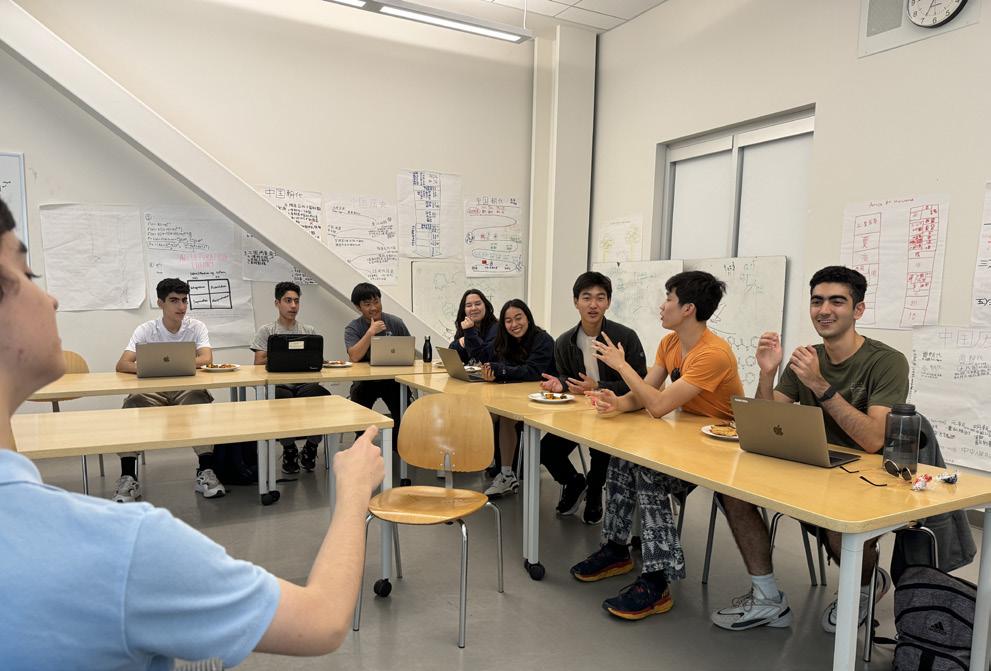
To Ted Theodosopoulos, reimagining pedagogy means foregrounding student agency through modules where students work in groups to create an open-ended artifact they present to the class in a symposium format. “Projects have multiple ways of being interpreted,” Theodosopoulos described. “And that's a feature, not a bug. That's something that would encourage genuine conversation and collaboration.”
ii.
Research-specific skills like documentation, knowledge extraction, communication, data analysis, and project management, are broadly applicable and drive learning and discovery. Nueva students and educators have thought of creative ways to prioritize transferable research skills as the primary outcome.
With Research at Nueva, we split these skills into actionable project deliverables—we call them nodes—that each involve a clear learning goal, avenues for achievement in classes, and instructions on how to demonstrate proficiency. In her BRT class, Ronan assesses students’ scientific journal reading through the depth of their reflections and iteration on their reading strategies, which are tracked in individual “literature diaries.” Meanwhile, Theodosopoulos assesses whether students understand the unique perspectives—“lenses”—of his various classes
source of growth can be much more helpful in dealing with the different sources of anxiety that life can bring.
through the artifacts students create in each module and the questions they ask. After taking a class, the facts may become obsolete over time, but your newfound way of thinking about the world and the ability to switch lenses will remain with you.
It’s common (and honestly, comforting) to think that in classes, we are searching for the right answer that is just around the corner. But that view inherently values rightness over wrongness, and to Theodosopoulos, being wrong is a core part of his pedagogy. In fact, he makes a concerted effort not to know the right answers when creating projects. “My gauge for the quality of a project is when [not knowing the answers] becomes difficult, when I really want to engage with it,” he said. To Ronan, success as a teacher looks like increasing resilience among students. She wants “kids [to] experience failures and both bounce back emotionally by leaning on their teammates and their teachers and also move forward to iterate and make progress.”
I see research as an ecosystem connecting classes, clubs, and independent projects, and in my time at Nueva, I have developed the belief that the basic components of that ecosystem are here. For example, classes like Ronan’s BRT and Theodosopoulos’s Models of Group Decisions work closely with the student-led DATAS (Discussions And Talks About Science) and Roundtable clubs, respectively.
Last year, the Research at Nueva team and I organized a school-wide research symposium that brought together students investigating schizophrenia in worm models, exploring the role of Pauli matrices in quantum information, modeling the effects of dollarization on the Argentinian economy, and adapting a traditional Chinese story into a published children’s book. The wealth of knowledge and interdisciplinary conversations were incredible. And the value of this research lies in sharing it with the larger community: all of our collaborations and feedback, skills and lenses, right and wrong answers. That is what a student-driven education looks like. Now, it’s in future Mavericks’ hands to explore.
Thank you, Ted and Jehnna, for your mentorship of Research at Nueva. Also, thanks to our leadership team and all the students, faculty, and administrators who supported our efforts to reimagine pedagogy.

In freshman year, I grew accustomed to the short stop and start of sobs, the rants over impending due dates, and shaking hands of stress. Maybe it was a friend or peer, maybe I was in the throes of anxiety myself. Perhaps it was over an English essay or a math packet, or later on, over the college application process.
Suffice to say, my first year of high school felt as though it was shadowed by stress. So I turned to find a solution, a quick fix that I thought had to exist. By the end of the year, I decided that Student Council was the best avenue to try to eliminate all the student stress I’d witnessed and experienced.
Looking back, I recognize my freshman naivete. No one person can solve stress, when it ebbs and flows with each wave of homework and is unique to each person.
I’ve come to accept that stress is not an issue that should—or can—be solved. There will always be outside pressures, or worries over the future, or something else to feel anxious about.
Instead, I think reframing stress as a
Stress is an incredible motivator. At least for me, I know I am not disciplined to always just do work for the sake of doing it. Worry over an impending due date, an exclamation of “I’ll never be good at this,” or the simple yet harsh realization of unfinished MAs are forms of short-term academic stress that are best embraced for academic progress.
Sometimes stress and academic obligation will become primary motivations to finish an English close reading or math packet, and that’s perfectly alright. The learning will remain the same.
That being said, stress can be unhealthy—resulting in intense mental burnout or panic attacks—and I aimed to acknowledge this by organizing donuts, department tutorial WOWs, and therapy dog visits. But these events could never fully eliminate all stress, academic or not, simply because stress does not exist without its source, whether it’s related to academics or not.
And so, I implore you to reimagine stress as a mere manifestation of your care, your passion, your incredible commitment to yourself or to whatever you are stressed over.
If you are worried about the future—
remember the excitement of dreaming about what could be and who you could be, while acknowledging the hard work that may take. If a deadline is approaching fast, let stress be a reminder of your academic progress so far, and turn your worries into adrenaline to keep going. If there’s a large culmination or event the next day, think of the perseverance and time that has already brought you to this day.
Over the course of my time as Academic Rep, I’ve learned to apply this approach to my own concerns and moments of worry. I refused to let it stall me, and instead, thought of it as motivation, and proof that I genuinely would accomplish what I was worried about. Stress made sure I kept up my deadlines, sent the right emails, and checked in with my peers every now and then. It also served as reassurance that I cared about the work I was pursuing, and pushed me to heights.
Once I was able to redefine it, stress wasn’t incessant but surprisingly helpful.
As I leave this position behind, I hope that you may have the chance to find a similarly new purpose in your anxious moments, continue to find the recurring traditions I’ve put into place as ways to alleviate stress, but never fully eradicate it.
Signing off, Ellie
Misconception #1: “Because I got a bad grade on this assignment, my teacher must hate me!”
I’m sure that’s not true—and it will only take a step out of your own head to disprove your statement. Go talk to your teacher and figure out where you can improve, instead of just worrying!
Misconception #2: “I deserve an A because I tried really hard.”
Though effort and persistence are undoubtedly habits of learning that you’re assessed on, they do not supersede academic excellence in overall importance. Talking to your teacher is the best way to figure out what you can actually do to improve your grade.
Misconception #3: “If my classmate does well, then I’ll get a worse grade.”
I’m always sad to hear this one, mostly because it contributes to a hyper-competitive mindset, a pretty unhealthy way to approach academics. This is simply not how it works; focus on your academic progress, and what you want to accomplish instead!
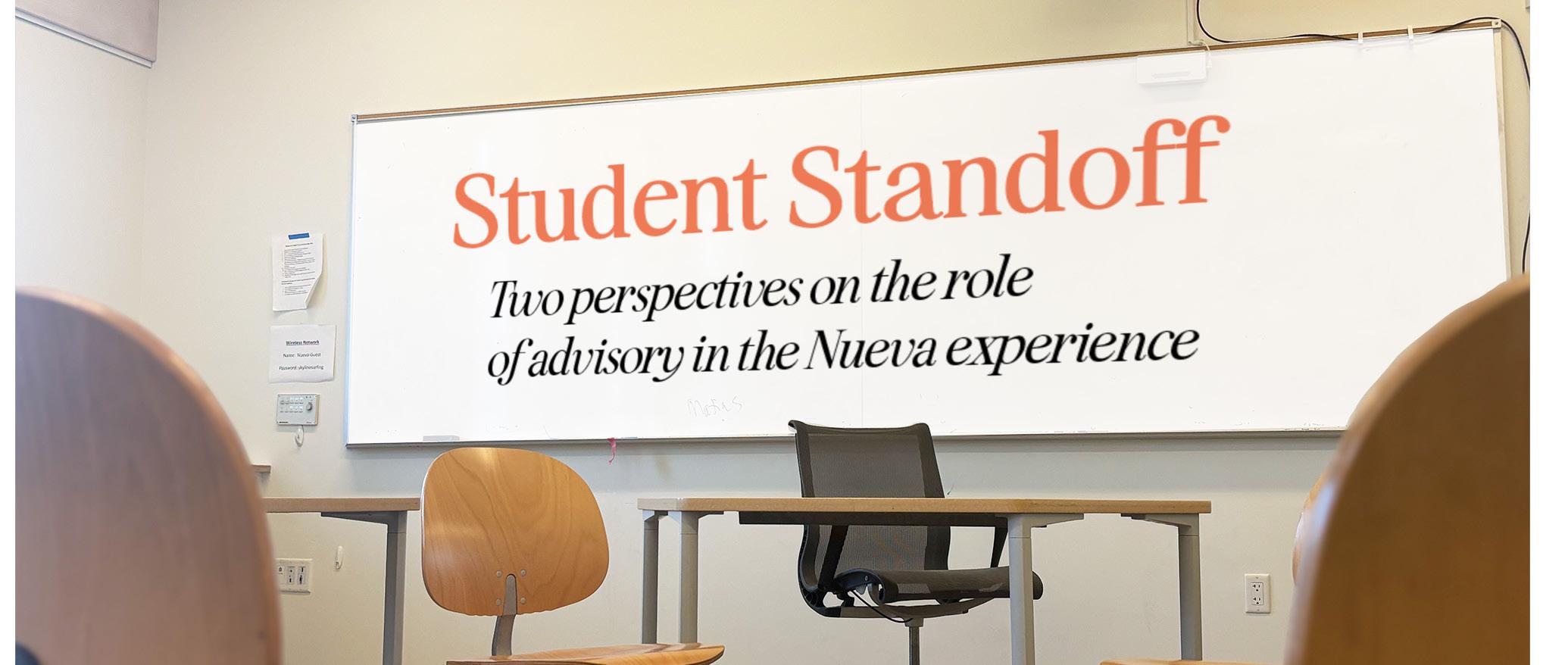
more one-on-one meetings with advisors, similar to the check-ins advisors did with their advisees during course selections.
From the time I joined Nueva, I’ve considered advisory more of a 30-minute free block before lunch than anything else. I’d talk to my friends, play games, and mindlessly watch YouTube videos while someone else played video games on full volume right next to me. And it is fairly enjoyable.

But that’s not what advisory is for.
According to the Nueva website, “Faculty-led advisory groups meet regularly to help students build friendships, set personal goals…Advisors are advocates for the students and are a vital communication link between parents and the school.”
Advisory has created a social network of people I otherwise wouldn’t have any classes with. I’ve met close friends solely because we were in the same advisory–in other words, advisory as it is now isn’t the worst thing in the world. It is meeting a lot of the points it was made for.
However, right now, advisory is lacking in a couple of key aspects: academic support and advisor-advisee relationships. As of now, advisory seems solely focused on socialization between students, and while not a bad thing, it doesn’t cover nearly as much educational guidance as I need.
And I’m not the only one who thinks that.
In a recent survey of 104 Upper School students conducted by students in the Journalism, Statistics, and Data Science electives, 40% of students rated the value of advisory as a 2 or less on a scale of 1 to 5.
“I think advisory is an untapped opportunity for getting to know people, learning study habits [and] how to succeed in high school,” one student wrote on the survey form. Other students wished there were

In order for advisors to properly advocate for their students, they need to understand their student’s troubles–something that one-on-one meetings and check-ins can help.
It is only once these bonds are built that advisors can properly support their students, whether academically or socially.
This isn’t only the advisors’ burden, though. Often, students groan at the sight
Both advisors and students have to make an effort to shape advisory into what it was designed to be.
of check-ins or discussions of academic support, and beg their advisors to play games or be on their computers instead.
“I think I could really enjoy advisory, but some of my students tell me pointblank that they hate it and constantly ask to leave,” said an advisor in another form in our survey. “It's really demoralizing to show up to something that I know my advisees are dreading.”
While these problems do not speak for every single advisory, they provide a good view into the various sides of the story. How can advisors constantly offer support for academics or otherwise and still provide free time for their students?
At the end of the day, both advisors and students have to make an effort to shape advisory into what it was designed to be. This means that students should engage more with advisory and actually state what they want, and advisors should advocate for more time to provide educational guidance, so we can form the advisory we want: a place where students can build bonds with each other and their advisors, and a safe space for advisees to ask for support from trusted adults.
By Kayla L. Opinion Editor
Lee and Jamie’s eleventh grade advisory?
Iconic. Pearl and Simon’s? The best. And, I’m not just saying that because I got to be part of them. Both advisories were and continue to be extremely meaningful parts of my Nueva experience.
My homebase away from home, advisory has always been a reliable gathering place for me to seek mentorship, develop friendships, and be gently forced to close my laptop to be present for a little while. In the bustling activity of Nueva, I believe advisories are essential spaces for me and my peers. I hope we continue to recognize the program’s deep importance and function in our community.
I have been fortunate to have positive experiences in advisories throughout my high school experience, and that success begins with the advisors.
Advice from teachers means everything to me, and I think an advisory grouping makes it much easier for any student to build a relationship with an adult at school. The impact of the advisor-advisee connection is profoundly positive.
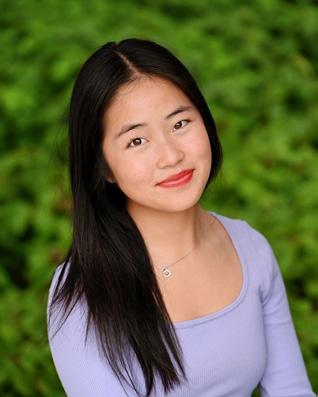
When my advisors have pulled me aside for a few individual check-ins each semester, I feel seen as not just a student—but a young person trying to navigate school, extracurriculars, and a social life at the same time. If I’m struggling with something, my advisors truly listen.
Their willingness to support me through thick and thin has made me feel safe and valued. As a young 9th grader, English teacher Pearl Bauer and History teacher Simon Brown grew to become my Nueva aunt and uncle,making sure that I was integrating well into the community and getting involved in activities I enjoy. This year, Mandarin teacher Jamie Gao and Head of School Lee Fertig have reassured me through the rapid development of a busy schedule and social anxieties.
Beyond the adults in the room, advisory is also a fun and low-stakes setting to meet new people in my grade. I know that the intentionally-diverse assignments can get flak, but I have genuinely enjoyed the surprising friendships that can only emerge from
What student survey respondents want more
"More socialization with other advisories" (10)
"More lunch time" (9)
"Homework time" (11)
advisory. Unlike class, I have time in advisory to talk with less familiar classmates about topics unrelated to The Great Gatsby, definite integrals, or 1980s world history.
Without advisory, there is no way I would have learned that Aiden N. ’26 is incredibly proud of a loquat tree in his backyard. I doubt Zach M. ’26 would have ever shared with me his whole, fascinating family history. I likely would never know that Emma W. ’26 loves attending concerts of the singer Regina Spektor.
These bonds are enabled by each advisee committing to fully participating in advisory. To help us, all of my advisors have more or less enforced homework and computer bans. Though it sometimes brings us stress to not be working or studying during advisory, I recently realized that a screen-free break is often exactly what we need.
I have fun, not despite, but because of the regulations. The slowed pace of advisory allows me to appreciate when Gao brings in lychee jellies. Or, just last week, an entire Chinese takeout feast! In ninth and tenth grade, Brown would lead our advisory in playing GeoGuessr, an online geography game that expanded our historical knowledge and created some playful competition.
Being present for two half-hour sessions each week isn’t just fun—I think it makes me a better member of this community. I get to slow down and gain a renewed appreciation of the people around me. My gratitude for others makes me excited to demonstrate my engagement; so, I sign up to bake advisory snacks, ‘co-preside’ over advisory games, and make TikTok lip syncs with the other advisees.
Some may say that advisory is not a helpful experience, and I know that there are some exceptions and imperfect fits when it comes to advisories. However, I believe that you can’t enjoy something if your mentality doesn’t allow you to. I have found, the more you buy into advisory, the more fun and utility you gain from it.
I hope others can derive the same value that I have gained from this core Nueva program. So, if I may advise my peers of a few things: turn off your phone, open up to your advisor, and ask a co-advisee about something they’re interested in.
"A more in depth relationship with my advisors" (11)
"Games and intra-advisory bonding" (9)
"Information and advice on academics and senior year" (11)
"Off-campus trips" (10)
"In my previous advisory, we built a pretty strong community through conversation and games, and I miss that somewhat" (11)
By Anwen C. Staff Writer

By Senya S. Staff Writer & Julia R. Guest Contributor

By Jackson H. Web Editor
The Nueva faculty has a high concentration of postgraduate degreeholders, but how familiar are you with their academic background? Draw lines connecting the teacher’s name to the title of their PhD thesis.
"Where It's At: The Making of Setting in American Fiction from Mississippi to Mars"
"There and Back Again: Regulation of Stem Cell Homeostasis and Dedifferentiation in the Drosophila Male Germline by me31b"
"The speciation of copper across active gradients in nitrogen-cycle processes in the eastern tropical South Pacific"
A New Deal Everyday: Civic Authority and Federal Policy in Chicago and Los Angeles, 1930-1940"
"Meditations in an emergency : social scientists and the problem of conflict in Cold War America"
"Modeling the effects of population structure and vaccination strategy on infectious diseases"
"'Faith is a fine invention': Emily Dickinson's Role(s) in Epistemology and Faith"
"Stochastic Models for Global Optimization"
A darker take on the viral self-help book of 2025
By Josie B. Editor in Chief
If they want to leave, let them. If they don’t support you, let them. If they don’t invite you, let them. If they walk a little too close behind you, let them; it’s a public sidewalk.
Stop wasting your energy and time trying to control people.
Let them if they want to choose something or someone over you. Let them watch you from the car across the street. Let them figure out which window you always forget to lock. If your friends are not inviting you out to brunch this weekend, let them. If you see the same person who was walking behind you last week standing behind you in your mirror while you brush your teeth, and then you turn around and see no one there, just let them.
So much time and energy is wasted on forcing others to match our expectations.
Marie Burks

Tom Dorrance

Allen Frost

Jeremy Jacquot

Lindy Jensen

Kathy Paur

Ted Theodosopoulos

Regina Yoong

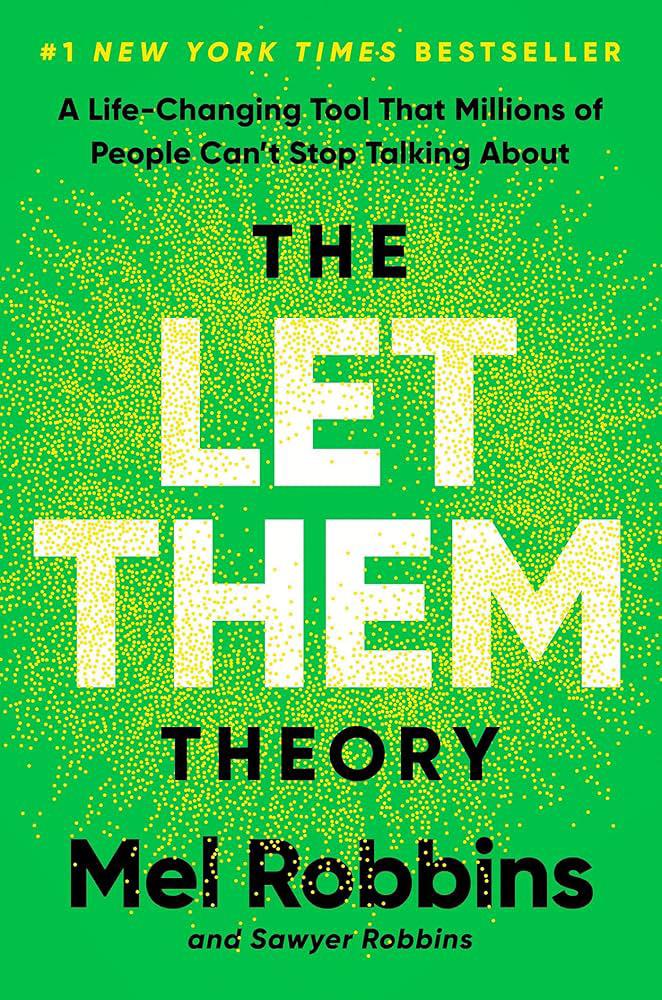
Let them call from a unknown number. Let them say your full government name.
And the truth is, if somebody else is not showing up how you want them to show up, do not try to force them to change. Let them be themselves because they are revealing who they are to you. Just Let Them.
Let them ring your doorbell, even if you didn’t give them your address. Let them say they were “just in the neighborhood,” and wanted to hang out.
Let them ask why you look scared. Let them inside when they ask; it’s rude not to. Let them walk down the hall and know exactly where the kitchen is, even though they have never been inside your house.
Let them get you tea. Drink it because you don’t want to be rude. Because you tell yourself: Let them. The dizziness hits fast. Your vision starts to fade. All you can think is: “I shouldn’t have let them.”
But it's okay! With Mel Robbins' theory, you don't have to think too much. Just Let Them!
By Kayla L. Opinion Editor
Yezen H. ’27 partook in “super nerdy stuff” as a seventh grader, playing Pokémon and largely uninterested in sports. Then, one day, he watched a video of professional mixed martial arts fighter Israel “Izzy” Adesanya. Adesanya is not only a former world champion in mixed martial arts (MMA) but also—a proud Pokémon merchandise collector.
“That's what piqued my interest in the sport. I saw it as the sport where I don't have to play up to be this jock and still do well,” Yezen said.
After watching Adesanya, Yezen could not stop thinking about MMA, which combines combat styles like Brazilian jiu-jitsu and wrestling into a dynamic fight between two athletes.
Yezen spent a few weeks at a beginner jiu-jitsu class before beginning to box at a different small gym in San Mateo. A few months later, he joined the San Jose American Kickboxing Academy (AKA), one of the world’s top-ranked MMA gyms, frequented by renowned UFC champions like Khabib Nurmagomedov and Daniel Cormier.
Though his progress was speedy, Yezen started with minimal athletic experience. “I was this skeleton, with a decently long reach, that tried jiujitsu,” he recalled. “I'm still built like a skeleton, but my muscles are a lot stronger. I can hold my own.”
Yezen now trains five to six days a week at AKA to pursue his passion for MMA. Through practice, he has developed the skills, strength, and discipline to approach various competitors within UFC’s unique octagonal cage. His love for the “strategic dance” of the sport is undeniable, and he has developed a belief that each fight is more significant than the brutality that MMA commonly carries a reputation for.
“I think what really made me fall in love with [MMA] is the strategic and rhythmic aspect of it, rather than physically getting hit. To find opportunities, you need to make


disruptions in the rhythm. It's a dance with very bad consequences if you mess up,” Yezen explained.
Yezen notes the regulations of MMA fights reduce brain injury risk to less than in “commonly-accepted” sports like football or hockey, but he still trains diligently to avoid severe harm and to prepare himself for sparring against others. After school and on weekends, he takes the train or drives to AKA, making a total trip of nearly two hours.
Once at the gym, his practice regimen varies day by day, from learning a new martial arts technique to circulating around different conditioning stations to boost general fitness.
Yet, the “best days,” according to Yezen, are limited to just once a week. On those days, he spars against his classmates, who range
from 12 to 30-year-olds. While sparring, Yezen is encouraged to leverage techniques from various martial art forms to form a creative combat approach. Sometimes, he also considers popular MMA fighters’ trademark styles, like his original inspiration Adesanya’s.
“I like the mental stimulation it brings you to analyze your opponents and to think about strategy,” Yezen said.
With each opportunity to spar a classmate, Yezen is conscientious about displaying appropriate sportsmanship, given the intensity of MMA.
“There's so much more than just two guys clobbering at each other's heads. Although it is violent, it is not that much of an angry sport. There's a lot of respect, because it’s a scary thing,” he said. “There's a huge amount of respect and camaraderie within the community, no matter what level you're at.”
Yezen's understanding of MMA as a respect-based sport is more complex than what the media and the

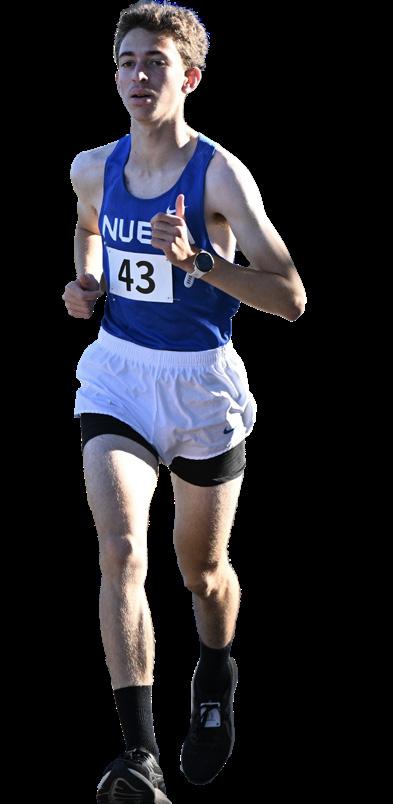

By Ethan H, Sports Editor
general public might understand it to be. “There's the idea that [MMA] is inhumane and it's this barbaric, human cockfighting. I think that sentiment is just so far from the truth,” he said.
In addition, Yezen explained, a hyper-conservative culture has emerged from Ultimate Fighting Championship (UFC), the foremost league for MMA. It also attracts many prominent right-wing figures.
Namely, UFC’s president is Dana White, a long-time friend of President Donald Trump. White has publicly endorsed Trump in the past, even introducing him at the Republican National Convention in 2024. UFC is also interconnected with manosphere influencers like Andrew Tate, Tristan Tate, and Joe Rogan, who are all former martial artists.
While attending a UFC event earlier this year, Yezen saw both Tate brothers sitting just rows in front of him.
Because Yezen's political beliefs are neither liberal nor conservative, but guided by his religion of Islam, he stands for a unique ideological position in MMA. He avoids political conversations at the gym, though, limiting distractions unrelated to the sport itself.
“It's a thing of disconnecting the artist from the art. Disconnecting beliefs from an athlete is, in my opinion, the best way to go,” he said.
Looking to the future, Yezen hopes to continue MMA recreationally while also pursuing his passion for neuroscience in school. He also wishes to see the sport grow in recognition and participation, as he believes it is particularly unique compared to many others.
“It's raw. Humans, primally, know what a fight is. They're not gonna know what a hockey game is. But you can look at a fight, and you're naturally going to have a reaction. Whether you're disgusted, intrigued, or excited, you're still watching it,” Yezen said. “That is really what sets [MMA] apart and makes it the sport that it is.”
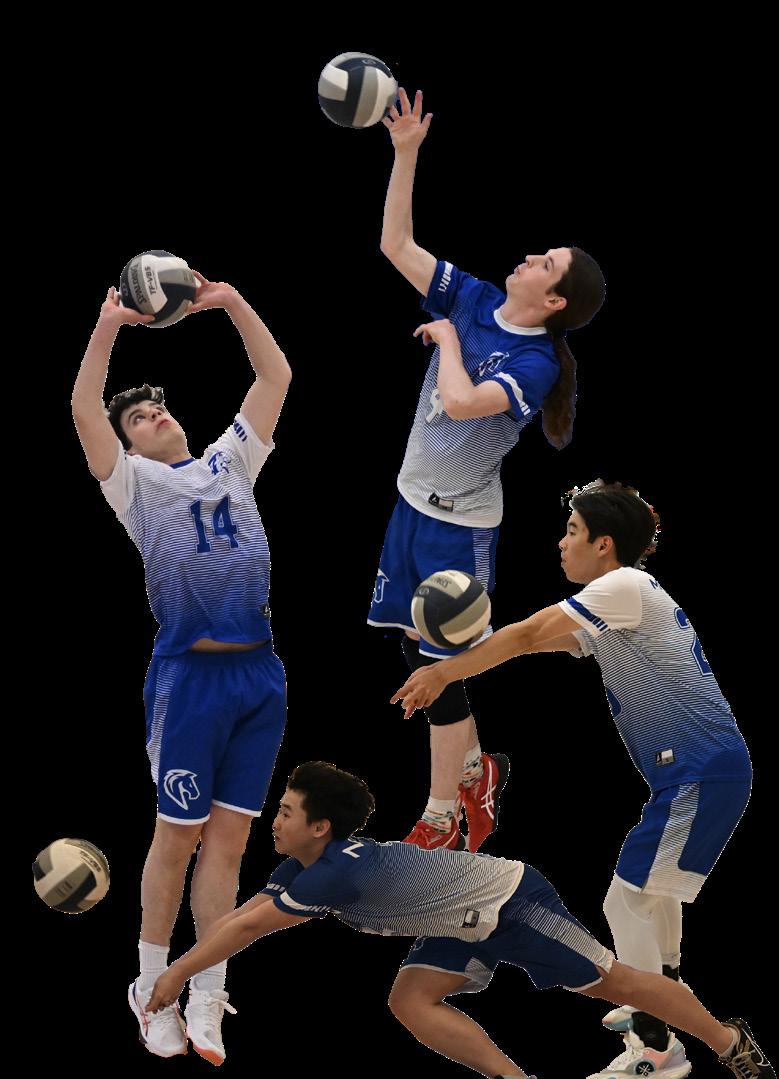
Story by Gabriel B. Features Editor
Additional Research by Rohan T. & Natalie S.
At season’s end, a typical assessment of a team’s success considers winloss records, hardware put on display, and banners raised in the gym. Those standard indicators, however, hide the variation between the schedules for different sports, revealing little about team performance relative to the school’s enrollment.
In order to expand upon the information that a win-loss record provides, Statistics students brainstormed a weighted game value based on the enrollment of opposing schools. Enrollment numbers were sourced from the California Interscholastic Federation directory.
The game value for a win equals the ratio of the opponent’s enrollment to Nueva’s. (The Upper School enrolls 451 students.) A loss is worth the negative reciprocal of the same ratio.
For example, girls tennis split its two matchups with The King’s Academy, which has 602 students. Since the King’s student body is 1.33 times larger, the win was worth 1.33 on the weighted scale, and the loss was worth -0.75.
Girls tennis finished with an 8–2 record, but about 10 weighted wins and 1 weighted loss. Two victories over Mercy Burlingame (384 students) and one over Notre Dame San Jose (670 students) impacted the weighted total most.
Note that in the analysis, enrollment at all-girls schools was doubled. While Mercy enrolls fewer students, it has close to double the pool for athletes in wgirls sports. Mercy and Notre Dame were considered 768 and 1340-student schools, respectively.

Girls volleyball finished with a 13–12 record, and the enrollment-weighted metric values those wins at 12.9, and the losses at -11.6. The weighted win-loss indicates success just above par for the size of Nueva. Had the team beaten every opponent with a smaller athlete pool and lost to all opponents with a larger one, its record would have come out to 11–14.
The most valuable win came against Kennedy High School in September, worth 2.77 points on the weighted scale.
The team suffered its worst loss to Pinewood, which enrolls 201 students in ninth through 12th grade. That defeat
makes it to the CCS qualifier through league for the first time ever
By Jordan F. Staff Writer
After five hours on the 18-hole course, the Upper School golf team made history by qualifying for CCS for the first time. The team advanced after placing second in the WBAL league champion ships, winning eight out of twelve matches throughout the season.
This year, the team broke its record of 190, the previous best score ever shot by combining the strokes of five players. At the WBAL league individual, James L. ’25 shot 69, winning the individual title while the team collectively shot 380.
After the season ended, James shared the reason for the team’s success in the league.
“Having some camaraderie and dedica tion from everyone made the golf season so successful. Everyone was willing to show up and give their best effort on a good day or a bad day.”
On May 6, the golf team placed sixth in the CCS qualifier. Freshman Bence O. also finished fifth individually, shooting 73 and qualifying for the CCS Champion ships by two strokes.
Durring his first match, Bence high lighted playing his match with Mo C. ’27, despite a rocky start.
“The match didn’t start off well, but Mo was really supportive. We were just there for each other for the

counted as a -2.24 game value, because Nueva enrolls 2.24 times more students than Pinewood.
A loss to Newark Memorial High School, where 1,363 students attend, only cost -0.33. In the standard loss column, it counted the same as any other game.
Girls soccer was a standout of the weighted analysis, with a 19–3 record despite playing just 12 games against smaller schools. The weighted value of the wins pencils out to 22.6, and the losses count for -1.84, meaning the average win for girls soccer was against an opponent with 1.19 times the enrollment. In the team’s
three losses, the opponent enrollment averaged 1,201.
By a wide margin, boys volleyball faced the hardest schedule. On average, opponents enrolled 1.85 times more students, as marked in the “strength of schedule” column. However, a defeat to Mountain View Academy—a school of 59 students—spoiled boys volleyball’s weighted record.
The accompanying visual lays out the picture of enrollment-weighted performance from the 2024-2025 year for all sports except cross country, track and field, swimming, and beach volleyball.
By Gabriel B. Features Editor
Daniel R. ’25 and Alaric L. ’25 were notably missing for a few hours on Thursday afternoon of the senior retreat. They were off at Independence High School in San Jose, where they joined Remi H. C. ’26 and Michael Y. ’26 for the Central Coast Section (CCS) swimming prelims. The four raced as part of the first swim relay team in school history to compete at CCS.
“I’m glad we had [Daniel and Alaric] on the relay team. This was an opportunity for us to have one last meet with them,” Michael said.
Remi led off with backstroke, and broke his own school record in a time of 24.55. Yang set a personal best of 28.51 on his 50-yard breaststroke leg, Daniel swam the butterfly in 27.08, and Alaric closed with the freestyle in 24.47. Alaric said he was “quivering” on the box before his anchor leg. Beyond the nerves, he was also recovering from a sprained ankle.
The same lineup had set a school record time of 1:45.67 in the 200 yard medley relay at WBAL Championships, and shaved another second off at CCS. The time of 1:44.61 placed them 36th out of 43 schools from across all divisions.
“I thought it was pretty cool that I was able to swim in CCS. I didn’t think I’d be able to do that in high school,” Daniel said.
The butterfly was a less familiar stroke for Daniel to swim, but he met his expectations for his leg of the relay. At WBAL Championships, Daniel set school records in
the 200 and 500-yard freestyle, his primary individual events.
The atmosphere at CCS and the team aspect of the relay gave Michael extra motivation. Each time he brought his head out of the water to breathe, he could hear the buzz.
“Swimming with a team and having them all cheer you on, and knowing that how you swim affects them as well—it makes you go faster for sure,” Michael said.
Remi also qualified for the 100-yard fly and 100 back at CCS, and finished those races in 53.91 and 54.51, respectively.
Two days prior to the boys’ prelims, Mollie G. ’27 placed fourth out of a field of 36 divers at CCS to qualify for the state meet.
“I had a couple little mistakes, but overall it went really well,” she said.
Mollie does not practice with school; she trains and competes with Stanford Diving Club. She was well-prepared for CCS because she had a major club meet the weekend before.
“At a meet you have to qualify for, like CCS, it’s mostly before who already do diving outside of school,” Mollie said. She went up against a number of her Stanford teammates at CCS, and advanced to State alongside a handful of them.
Mollie became the first diver to represent Nueva at the CIF State Championships in Clovis.
By Callum S. Staff Writer
T
he basketball world expected one half of this NBA Finals equation. The Oklahoma City Thunder, with their league-topping 68-14 record and MVP Shai Gilgeous-Alexander leading a roster brimming with young talent, were favorites to reach this stage.
But their opponents? The Indiana Pacers were the ultimate underdog in this year's playoffs, entering with just a 4% chance to win their conference. Yet, a month later, they have defied all odds in one of the most improbable runs in recent NBA history.
While Oklahoma City’s ascension followed a logical path—sweeping the Memphis Grizzlies, surviving a nail-biting seven-game series against the Denver Nuggets, then dismantling the Minnesota Timberwolves—Indiana’s path sounds fictitious.
The fourth-seeded Pacers exorcised
their playoff demons by sending the Milwaukee Bucks into a probable rebuild and humbling the top-seeded Cleveland Cavaliers in just five games. Their victory over the New York Knicks in the conference finals was defined by Tyrese Haliburton’s magical buzzer-beater in game one to cement their 23-point comeback and to force overtime.
The shot didn’t just flip the momentum of the game, it rewrote the narrative for the entire series, where they would sweep the Knicks in their first two games at home and win in six.
Cinderella stories don’t always get their fairy-tale ending, though. For all of the magic that Indiana has conjured, from Haliburton's performance in the clutch to Siakam's 2019-esque scoring, they now face a Thunder team that isn’t just the best in the league, but one of the most complete teams that the NBA has ever seen.
Oklahoma City is a juggernaut. They
By Alvin Y. News Editor
During the 2025 NFL draft, University of Colorado Boulder (CU) quarterback Shedeur Sanders and his fall to the fifth round shocked viewers across the country. His talent, which was previewed before the draft as “top-five potential” and seemed like a consensus first-round pick, fell all the way to the 5th round, where he was selected by the Cleveland Browns at pick 144.
At worst, Sanders was projected as a late first-round pick. Sure, he might not have been the generational prospect or have the immense ceiling that teams salivate for, but you don’t win the award for being the best quarterback in college football just for being the son of legendary NFL cornerback Deion Sanders, or having the most apparent personality in the NCAA. You win because you have the stats, talent, and command of the game to back it up.
During the draft, as the rounds increased and picks continued to grow, viewers still hadn’t heard Sanders’s name being announced from the podium. Then, scathing reports from anonymous NFL general managers began to slowly surface as the first day of the draft began to draw to an end. Sanders was criticized for his attitude, perceived entitlement, resistance to team interviews and private workouts, and especially for purposefully failing interviews with teams with lower records to increase the odds that he would be drafted to a better team.
It's important for any team’s quarterback to carry himself with some swagger and confidence, but to the extent that he was described as “uncoachable” and “arrogant” by multiple organizations’ front offices? There’s a real problem with how he was treated as a hero in college, and even as a representative of the entire team.
There lies the issue in the newest generation of collegiate athletes: their predetermined mindset of already being a top-end talent that any team or school would be lucky to have is running rampant throughout the NCAA. In response, professional leagues, along with the NCAA, are reminding students to stay

didn’t just finish with the best record in the league, they had the highest net rating, the second-highest rated offense, and a suffocating defense.
Their point guard, Shai GilgeousAlexander, is undoubtedly their most dangerous weapon. His play style, centered around his deadly midrange jumper and unscrupulous dramatic arm-flailing that consistently draws fouls, will be the

in line and possess the same persona that collegiate athletes have been maintaining before NIL became publicly acceptable.
Of course, even before NIL was acceptable without repercussions, athletes had been receiving payments from schools, even if they weren’t willing to admit it to the media. However, their behavior as grateful student-athletes willing to do anything to be drafted, no matter the team, is something that professional leagues want back.
Look at former Tennessee quarterback and UCLA’s new transfer quarterback, Nico Iamaleava. Originally, Iamaleava was expected to stay with Tennessee with an expected NIL deal of roughly two million dollars, but Iamaleava asked for four million dollars from the school, leading to Tennessee ignoring his offer and an eventual transfer to UCLA.
There’s nothing wrong with somebody wanting more money. However, the fact that Iamaleava was willing to challenge a football program that is known for its ability to produce multiple NFL-level quarterbacks for an extra two million dollars highlights the new generation and their inability to understand future consequences. Although Iamaleava was a highly touted recruit when entering
college—ranked behind generational talent Arch Manning, who has the possibility of surpassing his Hall of Fame uncles Peyton and Eli Manning—
Beyond believing that he was the cornerstone of the school and could bargain for a larger NIL deal to stay, Iamaleava severely damaged his reputation as a loyal quarterback and strengthened the idea that he is only playing for money, especially after he was willing to sacrifice his position at a top-tier college program.
The worst part about the situation is that Iamaleava is getting paid less to attend UCLA than he was originally supposed to earn with Tennessee. Iamaleava overstepped the boundaries of how a college athlete is supposed to behave and is paying the price that comes when greed outweighs NFL dreams.
The college sports landscape is changing, and naturally, student-athletes are changing alongside the rise in NIL. However, both professional teams and the NCAA are actively pushing against a culture of entitlement among athletes, prioritizing grit and determination over arrogance. Student-athletes should look at Sanders and Iamaleava as examples of what not to do as college athletes and instead prioritize long-term goals over the possibility of picking up extra money.
steepest hill for the Pacers to climb.
The clock is about to strike midnight on Indiana’s nonsensical playoff run unless they find a way to derail the Thunder, with Oklahoma City entering as the heaviest favorites to win the finals in several years.
With game one set to tip off this Thursday, we are bound to see one of these franchises win their first ever NBA finals trophy.
The track and field team ends their season with success
By Senna H. Staff Writer
The Nueva track and field team championed their last meet in the Private School Athletic League (PSAL) on May 9, where both the girls and boys teams won their fourth consecutive team championship.
The girls team won 10 individual and three relay championships, smashing five league championship meet records and four league records in the 400 meters race, the 300 hurdles, the 4x100 relay, and the discus.
The boys team gained three individual championships and one relay championship, and broke four league championship meet records and two league records in the 3200 meters and the 4x800 relay. In total, the team won 46 medals and set 40 personal bests at their final meet.
The girls team came in first place in all of the running events and two out of five of the field events for a total score of 211 points, with the school that placed second winning only 78 points. Meanwhile, the boys team had a final score of 144.5 points, with the next team coming in with 103 points, securing a fantastic team result.
Nueva athletes also excelled individually, with Ainsley H. ’26 and Ryan F. ’26 winning the PSAL Most Valuable Athlete awards voted on by the league coaches. Both runners raced undefeated all-season in their individual events and won four league titles at the PSAL Championships.
From the championship meet, the team sent 13 athletes to the Central Coast Section (CCS) semi-finals, where they set eight personal bests and four new school records in the girls shot put, girls discus, girls 4x400 relay, and girls 4x100 relay. Fitzpatrick, who runs the 3200 meter, advanced to the CCS finals, where he placed fourth with a personal best time of 9:04.87.
His finish at CCS finals capped off an already impressive season for the track and field team. With more than a dozen league meet records under their belt, the team closed their season with momentum and set the stage for future success.
By Kayla L. Opinion Editor & Ethan H. Sports Editor
En route to a fourth consecutive league championship, athletes on the girls track and field team also took initiative on campus this spring. They, alongside the athletics department, have recently helped to intentionally consider the experience for female athletes in numerous ways, such as diversifying representation among the coaching staff, increasing understanding of the female experiences related to physical and mental health in the previous all-male coaching staff, and establishing standards for coach-athlete communication.
Lila P. ’26, who runs for both the track and cross-country teams, was excited to converse with her coaches about these changes. “It definitely felt like we got to know our coaches in a new way, even after running for them for three years,” she said. “We had never had this kind of conversation before, and I think it really improved the dynamics of the team and made us excited.”
The girls have achieved some wins quickly, such as improvements to the coach onboarding process and the hiring of two female coaches. They have additional goals: eventually, they hope to collaborate with Upper School Division Head Liza Raynal and Director of Athletics & PE Brett McCabe to develop a ‘code of conduct’ for sports coaches to read and sign. The code will comprehensively advise interactions with all student-athletes, but it may include a section that specifically considers external pressures that stem from gender-based discrimination.
These considerations at Nueva are significant given the distinctive experiences for female runners and athletes in general, according to Jules S. ’26, a runner for the track team. Body image and difficult relationships with diet are issues that can affect
women significantly and in ways different from men.
Additionally, Julia shared that she has had to endure catcalling, being followed, and being recorded while out on runs independently or with Nueva. Though she acknowledges that this can be a problem across genders, she has not observed a male teammate struggle with it.
“If you're a high school girl who's going on her run, and you realize that someone's recording you, that's really jarring,” Julia shared. She then shared her experience until late April, when she and others advocated for the hiring of female coaches.
“When you come back to the team, and you see no female representation in the [leadership], you really do feel more isolated,” Julia said. “I had never really heard anyone talk about being a female runner and how that was difficult.”
Lila also considers athletics and gender inevitably intertwined. “Our running is a lot about our bodies. So I think our gender ends up reflected in it, because we have to be thinking about our bodies every single day,” she said.
So, Julia and Lila set up an initial meeting to share their thoughts with Lopez, who is also the track and field coach, in March. They were joined by two other teammates, and they together discussed potential solutions, support figures, and next steps to pursue.
Lopez was very supportive, according to Julia and Lila, and he wanted to hear everything they had to say.
“Everybody deserves to have a positive experience,” Lopez later said. And if they're not, then I want to know about it. Whether it's something within the team, within the coaching staff, or myself. If we
Story by Natalia R. Staff Writer
Additional Research by Jackson L. & Logan
X.
S
ince sports betting became legal in 38 states in 2018, the way fans watch professional sports—especially the NBA— has shifted. While betting has brought a new way to engage with the game, survey data collected by the Statistics and Data Science classes shows that it's also shifting attention away from the teams and toward individual stats or bets.
In 2018, the Supreme Court overturned the Professional and Amateur Sports Protection Act (PASPA) that had outlawed sports betting. The ruling allowed individual states to legalize and regulate the practice of placing wagers on the outcomes of sporting events: who will win a game, how many points will be scored, or how individual athletes will perform. Since then, sports betting has rapidly expanded. Nearly $495 billion has been legally wagered, according to public reports. The rise of online sportsbooks like FanDuel, DraftKings, and BetMGM has made betting more accessible than ever. These apps are designed to be easily navigated, providing clear odds and picks

can improve in one way or another, I want to know about it.”
They next met with Raynal and McCabe, who supported the hiring of two new female coaches. In response to the group’s requests, the coaching staff grew to include health and administrative aide Danae Flores and MS Associate teacher Addison Eftekhari, who have already profoundly affected the track and field athletes and will join the cross country coaching staff in the fall.
“The team culture is really flourishing with them. It's really only been a few weeks since they've really been like a part of our community, and you can already see the difference,” Julia said. Flores, for example, has begun to run with the long-distance girls team and boost team spirit.
Given his focus on building an enthusiastic culture surrounding athletics since his arrival in January 2023, McCabe was grateful that the group of students advocated for themselves, and that he was able to help make initial improvements. “We're going to take the time to meet with [student-athletes] and not only listen and talk,” he said. “If there are things that we can implement or do differently, we're going to do it, because it'll be the right thing to do.”
Raynal also offered to codify formal acknowledgements for coaches’ interactions with female athletes. She plans to partner with other members of the administration to develop a draft, and members of the running team will also draft a separate version. Then, they will come together to identify the key components for a final copy. Eventually, this document will guide each incoming sports coach toward intentional, professional, and caring conduct.
McCabe, meanwhile, has been developing several new processes to implement
into athletics in the future. To begin, the athletics administration will include an additional video module in coach onboarding that will provide specific information about coaching female athletes. Second, he is in collaboration with the SEL and DEI departments to bring in guest speakers to discuss how Nueva can best support its female athletes.
Beyond instruction for coaches, McCabe plans to regularly select sample athletes of both genders across all sports and personally meet with them, acknowledging that there are many moving parts to being a Nueva athlete that he may miss when present at just games and some practices. In these, there will be no agenda of any sort, in an effort to foster a natural conversation flow.
“[I’d like to] be in tune with our student athletes and what their day-today lives are like,” McCabe said. “What’s important to them? What are they feeling? What are they hearing? We want to know.”
For Lila and Julia, the next step in their process is to draft and finalize their coaches code of conduct in the next few months alongside other members of the girls running teams, Raynal, and McCabe. Then, they’ll return for their senior season with coaches Lopez, Flores, Eftekhari, and the remaining coaching staff.
Joined by new assistant coaches, Lopez aims to grow and make progress for the cross-country program, as he realizes that seeking opportunities to change and evolve is a core part of coaching athletics.
“If we're not learning from each other or we're not learning at all, then we shouldn't be coaching. I think as coaches, it is our responsibility,” he said. “I owe it to [the athletes] to always improve.”
that aim to help even first-time bettors get started.
“It’s a couple buttons and you’ve placed a bet,” said Rohan T. ’25. “There’s no learning curve for it.”
In 2021, the NBA announced that FanDuel and DraftKings would become co-official sports betting partners. Now, broadcasts integrate live odds, expert picks, and in-game promos—features designed to hold fan attention from tip-off to the final buzzer.
In a recent survey conducted by stu-
dents in the Data Science and Statistics electives, given to 262 members from various NBA or sports betting Reddit pages and Discord servers, the data showed that 90% of respondents who place bets believe their viewing habits change whenever they have money on an outcome. The received responses spanned 38 of the 50 states.
These results are reflected in the experience of Rohan, who uses the app Sleeper to place parlays on NBA games about once a week.
“When two games are at the same time, and I have something on both of them, I pay more attention to the one I bet [more] on,” said Rohan.
That prioritization is part of a broader trend: viewers are increasingly watching selectively, tuning in more when they have
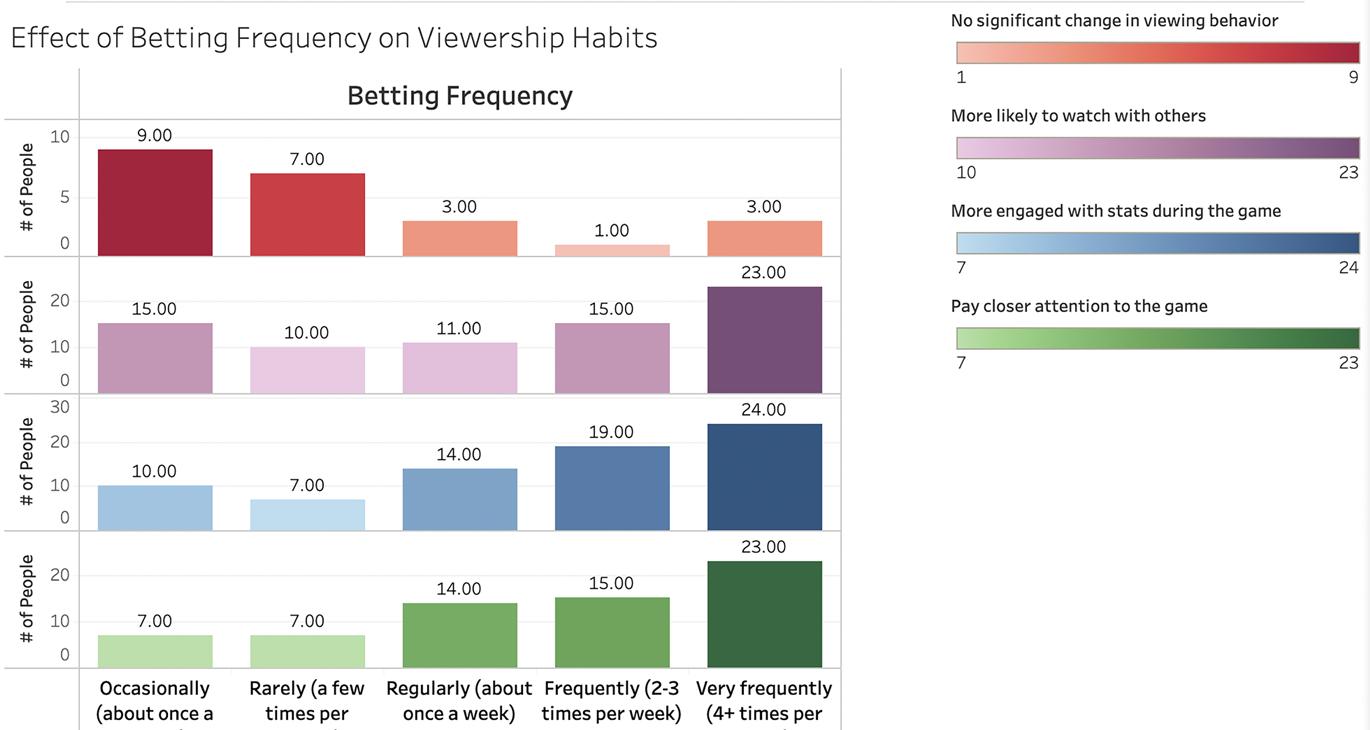
skin in the game.
“If there was a basketball player that I wanted to get 20 points, every single time the team gets the ball, I’m thinking, ‘please pass to this guy,’” said Landon X. ’25, another Sleeper user. “[Betting] at the same time makes it more fun to watch the game because you have something on the line.”
But more engagement doesn't mean more viewers. Despite the surge in sports betting, there is no clear correlation between how much is being wagered each year and regular-season viewership.
There is a correlation, however, between NBA household television ratings for the regular season and betting totals. Household ratings measure the percentage of households with TVs tuned to a game, while average viewership tracks individual viewers.
While betting totals have climbed since its legalization, the percentage of households watching games has dropped. This suggests that the increase in sports betting has led to fans engaging with the game through wagering rather than watching.